| Amateur Photographer magazine |
|
|
 |
| My favourite photography magazine
was, and still remains (though now only infrequently read), Amateur Photographer,
affectionately known by all its readers as 'AP'. Here follows my tribute to a magazine that first saw the light of day on Friday 10th October 1884 and is still being published every week. In the late 1950s, my mother purchased AP for me while I was still a teenager at school and I must have read (and re-read) almost all copies for at least a decade. I always looked forward to Wednesday when the latest issue arrived at the newsagents. |
| Being more technologist than a pictorialist, my favourite pages were the equipment tests, especially cameras and their lenses. I enjoyed seeing and comparing results from different manufacturers. AP's lens test procedure, from the mid-1950s until the early 1980s, was for them to take photographs across the Thames of the HQS Wellington, permanantly moored adjacent the north bank of the Thames, London, by the Victoria Embankment and Waterloo Bridge. Their repetitive use of a stationary test object, so that portions of 20x16 inch enlargements, from the centre and the edge of negatives, at different apertures, could be compared from one camera to another, was a 'real world' practical test that was elementary to understand. See 'The 1950s' below for a short article by Neville Maude (14th February 1968) justifying AP's choice of HQS Wellington as a test subject. |
|
|
|
Maybe after the camera tests my favourite pages were those by Victor Blackman (see right), the Daily Express photographer who wrote his weekly 2-page 'Photo Gossip', later (around mid-1963) called 'Cameravaria'. Later still, around 1980, it was called simply 'Blackman'. Very opinionated to the point of being exasperating, he strongly advocated using just one film and developer combination, which for 'Vic' were Kodak's Tri-X (400ASA) and D76. To his credit, he often mentioned the skill of his Fleet Street darkroom colleagues in producing quality prints from his negatives taken under all sorts of 'snatch' conditions. Victor (Gordon Charles) Blackman
died in the spring of 1988 (born late 1922) aged near 66 years.
My thanks to Vic's son, Nigel, for this information. The readers' letters pages and the readers' questions pages were also a 'must read'. And I drooled over the numerous advertisement pages showing equipment I couldn't possibly afford. 'Conversations at the Club' was another weekly inclusion, with the Old Gent, the Colonel, the Chemist, the Professional, the Fellow (FRPS) etc exchanging firmly held views on a wide variety of subjects, but in a good natured manner. The articles were illustrated with amusing cartoons that prompted me to read the text to find their relevance. |
|
|
|
Joël joined the Staff of AP on 12th September 1989 as Deputy Technical Editor, rising to become Technical Editor. He gave over this role to Damien Demolder in year 2000 but continued to write articles for AP until 2006. Joël is currently (Jan 2017) Editor of "Dorset Life – The Dorset Magazine". I have inserted relevant text
by Joël into my paragraphs below, with each starting: |
Chris has e-mailed (end July 2017) with his personal insight into the situation at AP from 1985 to 1989. See his contributions to this
web page at various places, below, each starting: |
|
"To put photographic magazines of the early 1980s into perspective, these were truly magnificent years. Amateur Photographer had the highest circulation of any UK photographic magazine with an ABC (Audit Bureau of Circulations) of around 110,000. The issues were as thick as an IKEA catalogue, mostly advertisements from dealers competing to sell their cameras, lenses and accessories at cheaper prices, or with faster service, or bundled as a great deal. 'Camera Choice’ had an ABC of more than 50,000 in its first year of publication. When the magazine closed in 1985, its ABC was in the 20,000s, which reflected the decline in the sale of photographic equipment. Most people had an SLR or good compact, and without anything especially gripping to attract them, they focused their spending on computers, videos, and video games". David Williams later worked for Amateur Photographer as a freelance writer from the mid-1980s and into the 1990s, when George Hughes and Keith Wilson were the Editors. David Williams continued to work as a journalist and then went on to study law, receiving an LLB (Hons). He worked in corporate communications, financial journalism and ran his own publishing company for 11 years, publishing a financial and medical title. He is now (2018) a 'digital nomad', working as a freelance editor, writer and film-maker. |
|
|
Introduction This issue was published on a Wednesday, a tradition which persisted for many years, though currently the magazines are dated to appear on a Saturday. Although the cover was in colour, all the internal pages were in black & white. It was not unusual for colour to be used on the cover (maybe just a single colour high-light), even back in the 1920s (see cover, left, below), but this would have been manually applied during the publishing process and not from any genuine colour photography process. Further examples of early covers are shown below the Jubilee Number banner. These are both priced at 3d (just over 1p). The special 'Open Air Number' had 50 pages. The physical size of the magazine at this time was around 21.2cm wide and 27.3cm long. |
 |
|
 |
||
 |
 |
 |
| The above cover is believed to be the cover of the bound set of 1884 editions, while further below can be seen the blue cover of the first issue (see The Amateur Photographer; 1884 ~ 1907) | The above two
issues are owned by Martin Reed. The left hand one is dated 11th
July 1888 and is a Special Number 'Photographic Holiday Work'.
Martin says "It's got a shot of the Forth rail bridge being
built, as well as the usual Clovelley cottages & portraits
of fishermen & yokels". It's priced at 1shilling (5p)
so an expensive purchase in 1888, but photography was a hobby
for the wealthy at that time. "It has 32 interior pages,
plus the 4sides of the covers, plus an extra page in the front,
being the picture that won a 1st prize. It's by no less than
Alfred Stieglitz of New York." The right hand issue is a normal 3pence (1p) weekly issue from Wednesday 10th September 1924. |
|

|
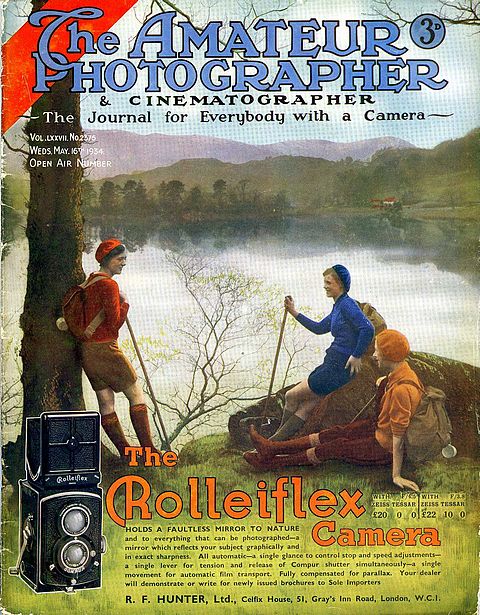
|
||
|
The Amateur Photographer; 1884 ~ 1907 In June, 1884, photography, already well established among professionals, was becoming an increasingly popular hobby, but its practice, with the apparatus and processes of that period, would be very difficult to visualise or understand by the modern amateur. The need for a special paper dealing with the subject from the amateur's side became quite definite at that time, and an enthusiastic photographer and journalist J.Harris Stone, M.A. evolved the idea of 'The Amateur Photographer'. A few months later (on Friday
October 10th 1884), in association with Charles W. Hastings,
who was engaged in the publication of other periodicals, the
first edition of "The A.P." was produced. The first issues were printed by John Smith & Co., of 52, Long Acre, and were edited and published from 22, Buckingham Street, Strand, London. Mr. Hastings becoming the manager of the publication. The firm of John Smith & Co. within a year or so of that date was taken over by Hazell, Watson & Viney, Ltd., who remained the printers and proprietors of the magazine until June 1918. |
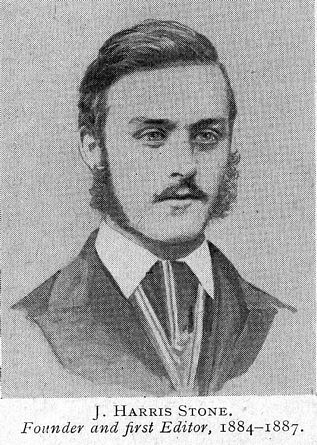 |
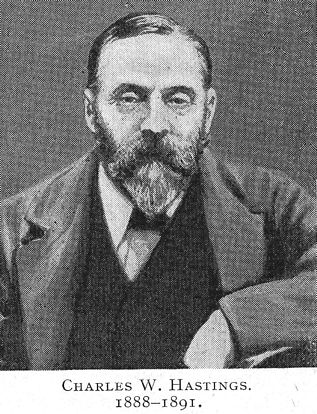 |
||
|
The first issue of "The A.P." appeared in a blue paper wrapper, and this was the colour of the cover until 1918. The early numbers contained an average of eight pages of editorial matter and eight pages of advertisements, and the price was twopence. There were no illustrations, but a pictorial inset appeared in December 1884. Illustrations and insets increased in number in the subsequent volumes as reproduction processes improved and the success of the paper became established. The first editorial clearly outlined the policy of the paper and this has been continued practically unchanged.
The first 'home' of "The A.P." was at 22, Buckingham Street, Strand, London, West Central. See illustration far right. |
|
 |
||
|
The postcard opposite was acquired by Geoff Hatherick at an auction. It was written by Alfred Stieglitz to Charles W Hastings in 1886. Alfred Stiegler, then age 24 (1864-1946), was born in Hoboken, New Jersey, but was studying engineering in Germany at the time he wrote this postcard (from Mittenwald, Bavaria).
After returning to New York in 1890, he was determined to prove that photography was a medium as capable of artistic expression as painting or sculpture. He edited 'Camera Notes', the journal of the Camera Club of New York and espoused his belief in the aesthetic potential of the medium. |
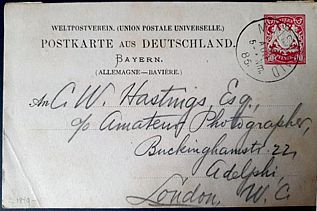
|

|
||
|
From its very first issue,
"The A.P." took the lead in all matters relating to
the welfare of the amateur, and the success which greeted its
appearance was a sure indication of the need for such a publication. In the first volume of "The A.P." will be found heated discussions on "Is Photography an Art?" and "Is Faking Permissible?" The first camera review, in issue No.1, dealt with "Marion's
Miniature Camera", a tiny but complicated instrument made
of metal and taking photographic plates (in dark slides) measuring
1¼ ins square! In 1888 J. Harris Stone gave up the editorship of The A.P. and Charles W. Hastings then became Editor (see his picture, above right). During the same year the first Kodak camera was reviewed. "The Dictionary of Photography" by E. J. Wall (Edward John Wall, see below, right), was serialised in the magazine's columns, being (at that time) just a glossary of photographic terms. The 1st 'true' edition of the Dictionary, published in 1889, was a reprint, with some small additions, of this glossary. Several Special Numbers of "The A.P." devoted to single subjects made their appearance, and numerous prize competitions were announced. T. C. Hepworth joined C. W. Hastings as joint Editor in 1889, and the offices were moved to 1, Creed Lane, Ludgate Hill, in the shadow of St.Paul's. George Eastman's (Kodak) celluloid roll film appeared in 1889 and was fully reviewed. Some far-seeing comments on its future were made by various writers in the paper. George Davison, a noted English photographer, proponent of impressionistic photography, co-founder of the Linked Ring Brotherhood of British artists and a managing director of Kodak UK. was the winner of the First Prize in an "A.P." competition. |
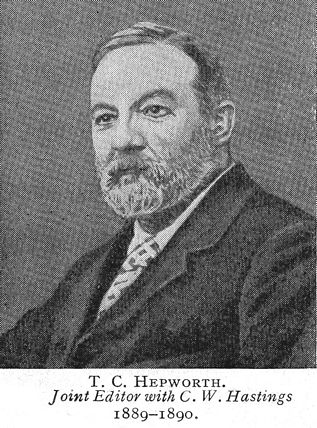
|
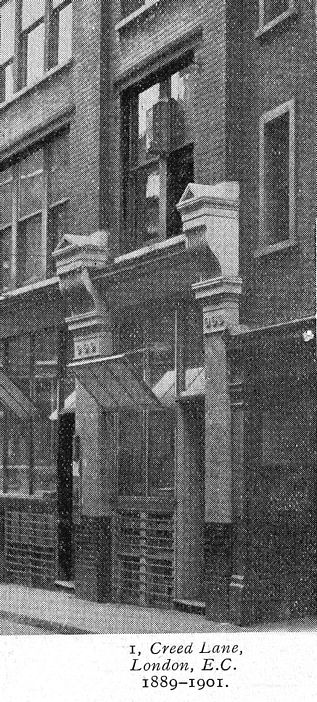 |
||
|
During the next few years The Amateur Photographer became the indispensable paper for amateurs in all parts of the world, and with a steadily growing circulation it was a great period for photographic invention and development. In 1892 C. W. Hastings sold his interest in "The A.P." to Hazell, Watson & Viney (who had controlling ownership of The A.P. from the mid-1880s), and E. J. Wall was appointed Editor. In the same year a monthly supplement was started, entitled "Our Lantern Screen", dealing with lantern and cinematograph matters. During Wall's editorship a translation of Eders' monumental work on Emulsion Photography ran as a serial in the paper. E.J. Wall specialised in answers to enquiries, and as such formed a tower of strength for the magazine. All difficulties were referred to him. It used to be said that "the weakest went to the Wall". In 1895 A. Horsley Hinton became Editor of The Amateur Photographer, and the pictorial side of photography received a great impetus. Hitherto the scientific and technical aspects of photography were the chief consideration. Under Hinton's editorship the possibilities of the camera for picture making became the dominant note. Plates, films and lenses had been improving year by year, and placing greater power in the hands of the amateur, and the illustrations in the paper became an outstanding feature. |
 |
 |
||
|
The cinematograph was also becoming a definite and more easily contrived apparatus within the scope of the amateur. New films and new developers were regularly appearing, and the (relatively small) hand camera had assumed such importance as to warrant the production of a Special Hand Camera Number of "The A.P." in 1896. Fifty examples were illustrated and described, though with just two exceptions, none were less than quarter-plate (3¼x4¼ ins) negative size ! In 1901 the editorial offices were moved by Messrs. Hazell, Watson & Viney from Creed Lane to their head offices at 52, Long Acre, Covent Garden, London, where it remained the home of the magazine for seventeen years, until the close of World War 1. The introduction of non-curling roll films and film packs in 1903 added still further to the simplification of photography for the amateur. The photographic societies were also showing a greater appreciation of pictorial work by amateurs, definitely due to the impetus of "The A.P." and many fine exhibitions were held in all parts of the country. In 1907 the autochrome plate was introduced, and R. Child Bayley made and showed the first examples in this country. The bromoil process was also invented. It was given its name by Francis James Mortimer (see far right), who held the first exhibition of bromoil work (at the Royal Photographic Society) in that year. |
 |
 Editor 1908-1918, Art Editor 1918-1925, Editor 1925-1944. Died as the result of enemy wartime action on 27th July 1944. |
||
|
The A.P. & P.N; 1908 ~ 1918 Horsley Hinton died in February,
1908, and 'The Amateur Photographer' combined with 'The
Photographic News' (The P.N.) in May of that year. A new phase of activity now started, and "The A.P. & P.N." increased in size with still more illustrations to the text and as supplementary art pages. "The A.P." Little Gallery at the offices of the paper in Long Acre was opened with a "Salon des Refuses"- the pictures that had been rejected at the Photographic Salon, largely as a result of what was termed "the American invasion". This led to the breaking of the Linked Ring, up to then responsible for the Salon, and the founding of the London Salon of Photography, in which the Editor of "The A.P." took a prominent part.
The medal shown here, measuring some 82mm x 82mm, dates to around 1910 and appears to show a photographer inspecting a negatives. The medal is heavy, maybe lead-filled, like a paper weight. The first 'Empire Number' of "The A.P." appeared in 1908 and definitely extended the influence of the paper overseas. A special competition was arranged for Colonial and Overseas readers. In 1911 the proprietors of "The A.P." acquired "Photograms of the Year" on the death of its founder, H. Snowden Ward. A new series in an enlarged format was started in 1912, with F.J. Mortimer as Editor. Cine cameras and projectors for amateurs made their appearance about this time and "The A.P." started a regular weekly feature, "Cinema Notes," to deal with this new development. This continued for many decades. In 1913 The Photographic Convention of the United Kingdom was held at Bangor, with the Editor of "The A.P." as President. From 1914 to 1918 the various World War 1 applications of photography were dealt with in the pages of "The A.P.", notably aerial photography. One thousand shillings (1,000s = £50) were raised in 1914 by the sale at a shilling each of a picture by the Editor, entitled "The Empire's Watchdogs". The money raised went to the Prince of Wales' Relief Fund. In 1917, the price of "The A.P." was raised from 2d to 3d (old pennies = 1.25p). |
||||
|
The A.P. & P;
1918 ~ 1926 In 1919 the inventor of the Carbro process, H. F. Farmer first described his new method of making carbon prints from bromides. In that year also the prize prints from "The A.P." Competitions were first shown at the Royal Photographic Society (R.P.S). Desensitising panchromatic plates was first described in 1920 and also a collection of £100 was made by subscriptions from readers for the Fox Talbot Memorial Fund. Owing to a paper shortage, the price of "The A.P." was temporarily raised to 4d, but reverted to 3d in 1923. In 1923 W.L.F. Wastell, the contributor of "Piffle," the humorous weekly page signed by "The Walrus" between January 17th 1903 and January 18th 1928, became Sub-Editor. The Walrus contributed a humorous commentary on the events of the day running to thirteen hundred pages without a gap of a single week. In 1925 R. Child Bayley retired from the editorship, but continued with the paper as Consulting Editor. He died in December 1934. F.J.Mortimer resumed his tenure as Editor. Other names associated with the magazine during these formative years were Thomas Bolas and Ward Muir. Bolas was a remarkable man, gifted in many obscure and little suspected ways. Under the head of "Acta Eruditorum', generally referred to as "Acta", he kept readers posted in the advances in science which bore on photography, week by week through many years. Ward Muir used the nom de plume "The Bandit" for his weekly "Critical Causerie". Although ostensibly limited to the work of beginners, it was found interesting to all who had pictorial leanings. Fresh, piquant and original, he maintained a standard such as no other writer challenged. Unfortunately he was handicapped by ill health, though only those who worked with him knew of the difficulties under which his delightful sketches were produced. Death alone brought to a close his connection with the magazine. During 1925 the number of snapshot amateur photographers and the D & P (commercial developing and printing) system had grown to a great extent and The A.P., to keep in touch with these thousands of new camera users, announced a popular weekly "Snapshot" competition in addition to the competitions which were regular monthly features. The new competition was for snapshots made by readers but commercially developed and printed. It proved an enormous success. In 1926 a free insurance scheme for insuring readers' cameras and other apparatus against loss and damage was inaugurated, and travelling exhibitions of the originals of the pictures in Photograms of the Year were started. |
 Sub-Editor from1923 to 1929 but submitted weekly articles for several further years |
|||
 Editor 1918 - 1925 (became Consulting Editor). Died December 1934. |
 |
 |
||
| The British Journal Photographic
Almanac for 1930, carries
interesting commentary by the (then) BJPA editor, George E. Brown,
on the early years of Amateur Photographer magazine. Click here to read the relevant text. |
||||
|
The A.P. & C; 1927 ~ 1933 The steady development of the amateur cine movement recorded week by week necessitated more space being devoted to it. Extra pages appeared specially dealing with the subject in 1927, and the title was altered to 'The Amateur Photographer and Cinematographer'. Another amateur photography magazine, 'The New Photographer', was amalgamated with The A.P. & C in 1928. W.L.F Wastell retired from the staff of A.P in 1929 but continued to supply weekly articles for a number of years. The editorship then reduced to F.J.Mortimer with R.Child Bayley still as Consulting Editor. R.Child Bayley died in December
1934, presumably leaving Francis Mortimer to carry on alone as
Editor. By the 1930s, photography had become a world-wide hobby with millions of followers; apparatus and materials had become so perfected that successful results were attainable by every beginner. At Easter 1933, the palatial buildings of Dorset House, Stamford Street, London, S.E.1, which had been in the course of construction for several years, were completed and became the home of the editorial offices of all the Iliffe publications, and so became the address of 'The Amateur Photographer and Cinematographer'.  |
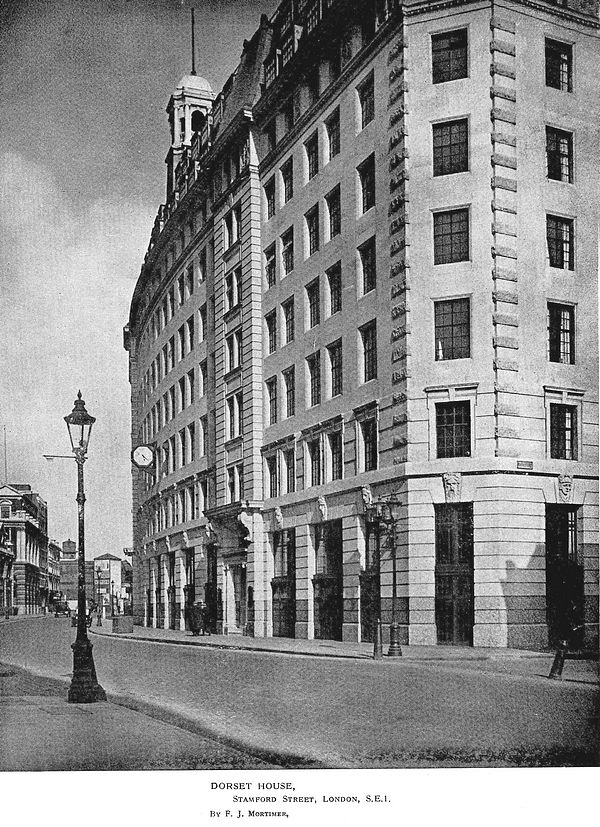 |
|||
|
The mid-1930s and Into the 1940s My AP collection has a gap until Wednesday August 18th 1943 (see its cover, right) so the following text is not a smooth progression from the previous date section. One long term contributor who had a regular 'slot' in the magazine from (at least) 1935, was 'Ricardo' who did "Picture Points", a textual and sketched critique of beginners photographs submitted by readers. He continued almost weekly until early 1964. By 1943, 'The A.P.' had acquired a new cover design but retained the previous font. Its title banner appeared in various colours (red, orange, green, light blue), perhaps used in chronological rotation (?). There was no longer mention of the Cinematographer or The New Photographer in the title, though the magazine continued to cater for cinematography interests. Its page size had reduced (not the thickness) compared to the 1920s and 1930s issues, being now some 18.3cm by 24.8cm (earlier editions were all 21.2cm by 27.3cm). The Editor, F.J.Mortimer (since 1908, Art Editor 1918-25, Editor 1925 to 1944) had, by August 1943, been joined by A.L.M.Sowerby as Technical Editor. Unfortunately, Francis James Mortimer died 27th July 1944, aged 69, as a result of injuries caused by enemy action. AP of 26th July 1944 stated that his injuries had been caused by a 'Flying Bomb' incident, probably a V-1 rocket (aka Flying Bomb or Buzz Bomb). David Likar, who has provided this information, suggests that perhaps Mortimer's injuries were caused indirectly from the blast. Although initially expected to recover, AP of 2nd August 1944 reported that he had died. The magazine was still at Dorset House, Stamford Street, but the price had risen to 6d (2.5p). Another contributor who continued
in place for a number of years (from 1941) was Lancelot Vining,
who contributed a column called "Miniature Camera Gossip".
Lancelot Vining was the author of a well respected book "My
Way with the Miniature" (referring to 35mm photography which
emerged from the Leitz and Zeiss stables in the late 1920s and
early 1930s respectively, via the sophisticated Leica and Contax
cameras). In the picture below, he is holding a Zeiss Contax. Lancelot Vining had formerly been a Daily Mirror newspaper photographer and after he retired from writing his AP column his place was taken by Victor Blackman, a Daily Express photographer, so a somewhat natural successor. Victor's picture is near the top right of this page and also together with Lancelot lower down this page. |
 |
|||
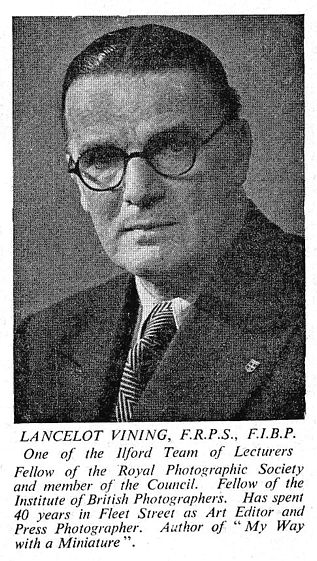 |
|

|
||
|
From 1945 (September 5th issue), the magazine cover design changed once again. It remained similar to the previous, but used a smaller font and 'The' before Amateur Photographer was then in small capitals, much less prominent. Clearly a precursor to it being dropped altogether (by the start of 1946). A.L.M.Sowerby was the Editor, assisted by R.H.Mason (Reg Mason) as the Consulting Art Editor. The magazine was still at Dorset House and still priced 6d. By January 1946, the magazine was just named Amateur Photographer (the use of a prefix 'The' had lapsed permanently). But it still had the sub-banner proclaiming "The Journal for Everybody with a Camera". By August 1949, another new cover design had appeared. The title banner was in sky blue colour and this colour was used every week. During the post-war 1940s, paper rationing impacted on the number of pages within AP, but by late 1949 the magazine was becoming noticeably thicker. The December 1949 issue, perhaps with more adverts than normal because of impending Christmas, consisted of 42 sides (21 pages) of advertisements, split equally either side of 18 sides (9 pages) of editorial, so 60 sides (30 pages) in total. |
||||
 Cover design 5th September, 1945 |
 Cover design 2nd January, 1946 |
 Cover design 31st August, 1949 |
||
|
The 1950s By April (or earlier) 1952, the price had risen to 'one shilling' (= 12 old pennies = 5p), but AP was still growing thicker. The April 1952 edition had 32 pages of adverts before 26 pages of editorial before another 20 pages of adverts, so 78 pages (sides) in total. |
||||
|
By mid-1952 an Assistant Editor had joined the editorial staff (of Sowerby & Mason), named H.Holmes.
The 21st January 1953 edition contained an editorial, plus a 2-page article by Harry Cooper, commemorating 100 years of the Royal Photographic Society viz: "It was 4 o'clock in the afternoon of January 20th 1853 that there was held, at the house of the Royal Society of Arts, a meeting of amateur photographers who passed a resolution to the effect that there should be formed a society to be called "The Photographic Society". This society went through two name changes before, in 1894, it became, by Royal Charter, "The Royal Photographic Society of Great Britain". It has since become universally known by its intials, the R.P.S. The same issue contained a 2-page article examining the change in photographic methods and processes over the same hundred years, 1853-1953. Download it here. May 27th 1953 saw a 'Coronation Issue', almost entirely devoted to the photographic aspects of the Coronation of Queen Elizabeth II on 2nd June 1953. It included a route map, both diagrammatic and in pictures, views inside Westminster Abbey, an article on 'Photographing Processions', and how to take photographs from a domestic television screen. At that time, TVs showed only coarse definition 405 line images in black & white. And few people owned a TV, there being only 2.7million sets in use within the whole UK. By March 1954 the typical number of pages had grown again, now to 104 (sides). This consisted of 44 pages of adverts, then 32 pages of editorial followed by a further 28 pages of adverts. Sometime during 1954, between March and December, a new cover design appeared (see right) and the magazine had grown in page area from the previous, around 18.3cm by 24.8cm, to around 21cm by 26.8cm, this being similar to the size during (at least) the 1920s and 1930s. Despite this larger size, the price remained at one shilling (5p). |
 Cover design 8th December, 1954 |
|||
|
By the end of 1954, the Assistant Editor's name of H.Holmes (who joined during 1952) is no longer listed with the editorial staff, which has reverted to being just A.L.M.Sowerby as the Editor, assisted by R.H.Mason. The Christmas edition published on 8th December 1954 contained 148 pages (sides), split 68 as adverts, 40 editorial and then a further 40 adverts. But even the previous week's (normal) edition contained 112 pages (sides), 48 pages of adverts, 32 pages of editorial and 32 pages of adverts. A dispute within the Printing Trade began towards the end of January 1956 and continued for around 1 month, to late February. There was a ban on overtime and a 'work-to-rule' by the typographical unions, around the subject of minimum rates of pay. This caused difficulties for AP in that several issues were considerably reduced in number of pages. Their 1st, 8th and 15th February editions carried the note on the News and Reviews page that "Owing to the dispute in the Printing Trade this issue has had to be reduced in size and copies may be late reaching readers. To all who are inconvenienced in any way, we offer our sincere regrets in circumstances beyond our control". The 22nd February issue contained the following on the first editorial page: "Readers will be aware of the continuance of the dispute in the Printing Trade. In consequence, this issue has had to be reduced in size. To all readers and to advertisers we offer our sincere regrets in circumstances beyond our control". That issue contained just 8 pages (sides) of adverts, followed by 24 sides of editorial, so only 32 pages (sides) in total. The price remained at one shilling (= 5p). During the autumn of 1956, between the start of November and before 12th December, the magazine price had risen to 1 shilling and 3 (old) pence (just over 6p). Below is shown an example of the AP camera lens testing procedure, using the HQS Wellington photographed across the Thames from the south embankment near Waterloo Bridge. The procedure was first used to test the Adox Sport Model II '8 on 120' folding roll film camera, supplied by Wallace Heaton Ltd, 127 New Bond Street, London, W.1. The test appeared in 7th April 1954 edition. Prior to that time, lens tests were carried out using a lens testing chart with results cited as the lens resolving power in lines per mm (lpm). Full camera tests were infrequent post-WW2 until the mid-1950s. Thereafter, they gradually became relatively commonplace. Amateur Photographer for 14th
February 1968 carried a short article by Neville Maude justifying
AP's approach to lens and camera testing. |
||||
.jpg) .jpg) |
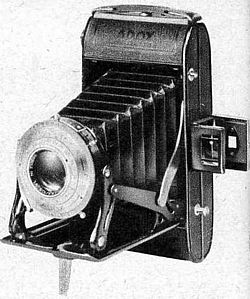 Adox Sport Model 11; price £14.19s (£14.95p) Folding camera producing 8cm x 6cm negatives, 8 on 120 roll film. First test using HQS Wellington |
|||
|
Six further changes occured prior to the end of the 1950s, but throughout the price remained at 1 shilling and 3 pence (15 old pennies = 6p).
|
 Index to Issue of 2nd September 1959 |
|||
 Index to Issue of 23rd December 1959 |
||||
 Front Cover, 11th June 1958 Colour Number |
 One of 12 inside colour pages (4 of them being adverts) |
 Rear Cover, 11th June 1958 |
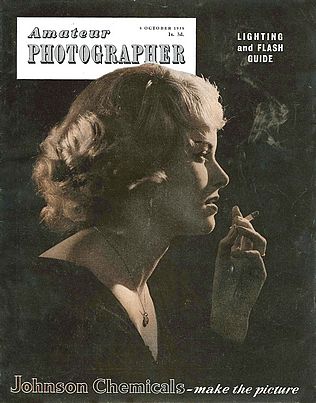 Lighting and Flash Guide (12 sides) 8th October 1958 |
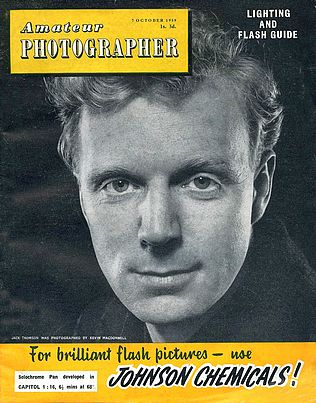 Lighting and Flash Guide (12 sides) 7th October 1959 |
 An 'Ordinary' Issue 23rd December 1959 |
|
The (Swinging) 1960s The 1960s saw AP reverting to using various colours for the front cover title banner, and not just keeping to blue for non-special issues. The Christmas Presents Number of 7th December 1960, seems to have been the thickest thus far, having 98 sides (49 pages) of adverts, followed by 50 sides (25 pages) of editorial and then a further 48 sides (24 pages) of adverts. See its front cover to the right. Still priced at 1s and 3d (6p). The list of editors remained the same and the contributors still included Lancelot Vining, 'Ricardo' and George Wakefield. In January 1961, a new name and position appears on the editorial page, this was Arthur B. Bourne, Managing Director. Mike Evans has e-mailed (February 2024) to say that Arthur Bourne had been editor of 'The Motor Cycle' magazine during the 1930s and 1940s. He wrote under the pseudonym of 'Torrens'. Mike describes Arthur as "a rather pompous and self-important man" but Mike is grateful to him for his first job as a journalist in 1962, at a salary of £8 per week. Puffing on his pipe, Arthur said, "we'll give you a gallop, old chap, and see how you get on". At that time 'The Motor Cycle' was also published in Dorset House , Stamford Street. "We were on the sixth floor, at the Paris Gardens end, while AP were (I think) two floors below in the same general area of the building". Mike recalls that all magazines based in Dorset House shared the same 'Photographic Department' which was based in a row of terraced houses on the opposite side of Stamford Street. The manager was John Yoxall, later superseded by Bill Banks. There were studios for product photography (enormous old wooded plate cameras) and the offices of the roving photographic staff. There were maybe half a dozen specialists who worked on contract for magazines as required. One of them, at the time Mike was there, was Don Morley who went on to become a very well known news photographer and founder of the 'All Sports' photographic agency. At the time they had just transitioned from using old fashioned press cameras to the new-fangled Pentax Spotmatic! (from 1964). Mike Evans came into frequent contact with Neville Maude, who was consulted from time to time on photographic matters. "Another well-known photographer attached to the photographic department in Dorset House was Geoff Ryden who was extremely well known and, I think, the senior photographer in the early 1960s. I remember he was known for his work on Autocar and Flight and, course, would have worked for AP". Sometime between the 5th April 1961 issue and the one for 7th June, the long term contributor (Willoughby) Lancelot Vining (F.R.P.S., F.I.B.P.), produced his final 'Miniature Camera Gossip'. Since Lancelot was born on 10th April 1880, he may have purposely decided to 'hang up his camera bag' on or around his 81st birthday, suffering from "an over-worked heart". Lancelot began his photographic career in 1894 as a boy working in an photographic agency and using a half-plate camera. He ended up a top camerman on the Daily Mirror newspaper. His place at AP was taken by a 45 year old Victor (Vic) Blackman, who referred to reading Lancelot Vining's column when it first appeared "in the mid-thirties", when Vic was just a schoolboy. When Vic first started writing his 'Photo Gossip' (later Cameravaria) it was just one page, but it quickly became a popular double page spread. Vic visited Lancelot at home a year or so after Lancelot retired from writing for AP and reported on that visit in his Photo Gossip column in the 28th November 1962 issue. A photograph of the two of them together is shown below. In 1962, the price of AP rose to 1s and 6d (18 old pennies = 7.5p). |
 Christmas Presents Number 7th December 1960 |
|
 |
 200 pages (sides), incl 28 pages of Camera Guide; 12th July 1961 |
|
|
It first appeared in 1950 and ran until the end of 1961. We were never told who wrote these pages (1½ sides originally but 2 sides by 1952). By 1954 the text became illustrated by amusing cartoons, see alongside here. By early 1962 the name of Charles Johnson had disappeared from the editorial list as one of the Assistant Editors (previously alongside Norman Dyer). Neville Maude's name was appearing more frequently, including being credited with the Camera Tests. In the 7th March 1962 issue, he reported on tests of the Rolleiflex Wide Angle camera. The same issue contained a 16 page (sides) Guide to Rangefinders, Exposure Meters, Tripods and Filters and was entitled the Outdoor Number. Neville Maude, previously Queries Editor, became the Technical Editor during mid-1962. By 16th May 1962, the Managing Director was Alan Wood, replacing Arthur B. Bourne. By 25th July, the Production Editor was no longer Hugh Burton but Gordon Malthouse. Gordon joined AP in late 1961 (News of the Week, 29th November 1961; "Mr Malthouse will be collaborating with Norman Dyer on cine matters and also assisting in the production of the journal as a whole"). Gordon Spencer Malthouse had been editor of 'Miniature Camera World' magazine before WW2, but had said 'au revoir' to his readers in June 1941 due to a paper shortage and general war time disruptions. The magazine reappeared post-WW2 and became incorporated into the magazine 'Camera World' around 1953, still under the editorship of Gordon Malthouse. 'Camera World' continued until (at least) the end of 1958, price 1 shilling and 6 pence = 7.5p. At that time AP was cheaper, 1 shilling and 3 pence = just over 6p, and was far more substantial due to its abundant advertisement pages. AP had maybe 60 pages instead of Camera World's 25 (50 sides), so perhaps 'Camera World' succumbed to commercial pressure and Gordon Malthouse joined AP. During early 1963 (certainly by 6th March) Alec Fry joined the AP team, leading the Enquiry Service. But he stayed for only 12months, as his name was no longer mentioned by April 1964. During his tenure, the 'readers ask' page was co-authored by Neville Maude and Alec Fry. To the right is shown the editorial list of names as at 6th March 1963. |
 |
|
|
Further editorial changes took place towards the end of 1963. R (Reg) Mason became the named Editor (1963-76) by September, with A.L.M. Sowerby becoming Editor-in-Chief. By 4th December 1963, the long serving A.L.M. Sowerby (on the staff for 20 years) must have retired, because his name is no longer on the editorial staff list. Reg Mason's name was then prominent as Editor, see his photo', right, in mid-1964. He reported, in the 29th April 1964 edition, that AP's circulation had been rising steadily for many years and the latest figure (certified by ABC = the Audit Bureau of Circulation) was 91,442 copies sold weekly, an increase of 6,244 copies (over 7%) compared to 1963. This circulation 'translated' into 5million copies per year and 15million per year readership. The name Alec Fry was missing from the editorial list by April 1964. His place as 'Queries Editor' was taken by Derek Keeling by June 1964. Derek was formerly a photography lecturer at the S.E. Essex Technical College and subsequently an employee of Kodak Ltd, responsible for answering their customers' queries. See his photo' far right, 1964. |
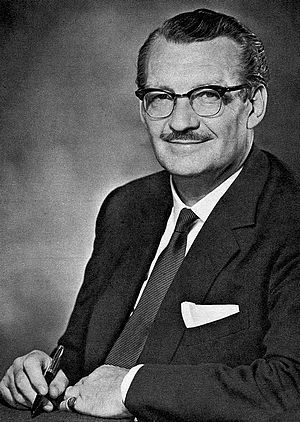 |
 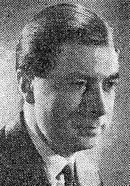 Derek Keeling, 1964 Derek Keeling, 1964 |
|
Ricardo was still (albeit only occasionally) doing his critique of reader's photographs and illustrating his comments with the original picture plus sketches of the original, showing how he believed the original might have been improved if only the photographer had done this or that. He must have been the longest serving contributor after Lancelot Vining retired - a full 30 years. Ricardo's pages continued to appear until (at least) the end of 1965, but certainly not weekly. After such a long time producing this contribution, which must have taken significant time to prepare, considering the thought and sketches that he used in his critique, he was probably ready for a break (assuming the same man had used the name 'Ricardo' for the full 30 years ?). Photography had changed over the 30 years that Ricardo had been writing. The desire (indeed, the strict necessity for exhibition work) to adhere to pictorial compositional arrangements (such photographers were called pictorialists) had largely passed away, though the basic rules of good composition are timeless and will always remain, whatever the medium. Photography had become much more a medium to spontaneously capture the moment, rather than one to be applied to duplicating the static excellence of 'old master' artists. The static approach had come from the early days of photography, when setting up a large plate camera on a tripod would have been much like setting up an artist's easel. Also, the long exposures and few photographic plates (exposures) available during an expedition, required the photographer to consider everything in the picture before releasing the shutter. He had time to do this as he was unlikely to be tackling rapid movement. To the right is a print Ricardo
received from a 13 year old boy (surprisingly with access to
a Leica 111G camera) which Ricardo complimented, and then commented
on as follows, in the 15th August 1962 issue: |
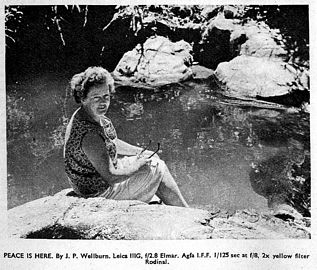  An example from one of Ricardo's last pages |
|
 3rd June 1964, Colour Number |
 9th September 1964, Enlarger & Projector Guide |
 16th May 1966, Colour Number |
|
The small cover picture, left, is just a copy of the cover included on the 'Readers Write' page of the prior edition, 4th January 1967. AP wanted to be sure readers recognised AP on the newstand bookstall the following week "From next week AP appears in a new cover. This (as left) is the attractive design of the first of the new picture formats you'll find awaiting you on the bookstalls." The new lower case 'ap' is used in various headings throughout the issue. The price remained at 1shilling and 6pence (18 old pennies = 7½p), as from 1962, despite inflation. The magazine seems to have made use of lower quality paper, maybe for cost saving to avoid a price increase. Some 'normal' editions also seem thinner, though maybe in part due to the change in paper quality rather than a reduction in pages. The issue shown to the right, dated 12th April 1967, had 'only' 57 pages (114 sides), but the Camera Guide issue, 7th June, had a full colour cover, 96 pages in all (192 sides) with 6 sides in full colour and 25 sides of camera guide. See cover below, left. At least three other 1967 issues had full colour covers, being 26th April 'Beginners Guide to Colour', the 6th September 'Enlarger and Projector Guide' and the 1st November 'Lighting and Flash Guide'. |
 |
|
 New cover design. 7th June 1967 and Camera Guide |
 New cover design. 21st February 1968 |
 First inside page, 30th October 1968 |
|
In 1968, Amateur Photographer reverted to more of a 'conventional' cover design, different from the covers in 1967 but also different from the pre-1967 covers. For an example, see the centre picture above, of a cover in February 1968. But this cover change was only one of several noteable features.
On a general note, News of the Week, in the 6th March issue, reported that support for Retail Price Maintenance (RPM) by the photographic trade's Manufacturer's and Importers Association, had been effectively withdrawn, leading to speculation that RPM would shortly cease (as indeed, shortly thereafter, it did). 1969 saw the appointment of a new Assistant Editor, namely Rex Hayman, though later in the year he was given the title of Queries Editor. By 31st December the editorial names list was as shown right (lower list). The cover of the last issue from the 1960s can be seen below, featuring actress Gina Lollobrigida. |
 Editorial names at 30th October 1968  Editorial names at 31st December 1969 |
|
|
By late 1969, a significant
number of pages were being given over to cine cameras and film
making. This was not a new addiiton, as the topic had been included
since 1927 (see above). Sections were entitled “The Cine
Scene” and “Sound and Pictures”. Strangely, there
was an article in the 12th December 1969 ediiton dealing with
9.5mm film, a film format where the sprocket
holes were posiitoned down the middle of the film between each
frame. This is surprising as the use of 9.5mm must have been
a rarity by that time. Enthusiastic amateurs would have changed
over from their previous "Standard 8" to "Super 8”
film format. “Super 8” was a version of 8mm film with
a larger picture area and improved user convenience. It was introduced
by Kodak in 1965. |
||
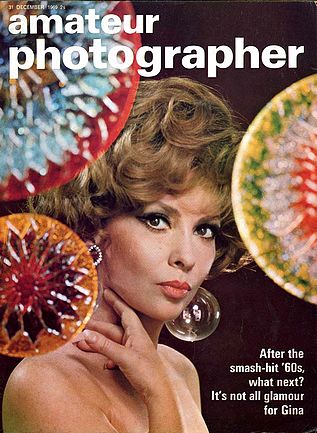 Front cover. 31st December 1969 |
 |
 |
 |
 |
|
|
The 1970s Continuing its encompassing of the hi-fi trend, the 21st January edition had not only 'The ABC of Flash' on the front cover, to appeal to photographers, but also it proclaimed 'Audio section', in an attempt to attract readers who had interests in both hobbies. This issue, apart from other audi topics, contained a test (by Derek Gordon) of a Rotel stereo amplifier and separate Rotel stereo tuner. The reason, or excuse, for incorporating audio into what had previously been a photography magazine, was claimed to be those photographers who wished to add sound to their cine film or slide shows A notable change to the editorial staff occurs between the 4th February 1970 and the 25th November 1970, when the long serving (since January 1958) Technical Editor, Neville Maude, left the staff list. One of his last camera tests of the HQS Wellington, was the Mamiya C330 interchangeable lens twin lens reflex (TLR). During this same time period, AP moved from their Dorset House, London address (where they'd been since spring 1933; see top address, right) to Fleet Street, London (see middle address, right). They remained there until (at least) February 1971 but, by September 1975, AP has been relocated in Sutton, Surrey (see bottom address, right). |
 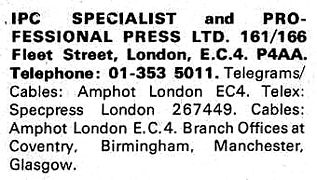  |
 List of editorial names, September 1975 Gordon Malthouse, replaced by Duncan Prowse Neville Maude, replaced by Rex Hayman Ray Arnold, replaced by James Blazeby Alan Wood, no replacement. Alan Shriver, Editorial Assistant John Tointon, Advertisement Director James Blazeby, Advertisement Manager from Queries to Technical Editor. |
|
The 10th February 1971 issue, apart from having a Sound & Vision Supplement (Part 1), also had on its cover the pricing information "2s (10p)", acknowledging the pending (15th February) Decimalisation Day in the UK, when 1 shilling became 5 new pence and there were no longer 240 pennies to the £, but 100 new pennies. To the right can be seen the 24th September 1975 cover. The editorial names list was as shown to the extreme right and above. Other changes by 1975 (or earlier, though after February 1971), were:
|
 Front cover. 24th September 1975 |
|
|
In 1976, R.H. (Reg) Mason,
who had been Consultant Art Editor of AP from 1946 until 1963,
and Editor from 1963 to 1976, left AP's editorial staff (born
1915, died 3rd June 1991). Reg Mason was replaced by Martin
Hodder (Editor 1976-1980). The 1st June edition was a 'Silver Jubilee Special Issue' celebrating Queen Elizabeth II's 25 years reign. It was a 'bumper' edition containing 266 sides (133 pages) plus the cover. Most of the articles blended photographic interest with a Jubilee theme. The cover can be seen below, centre. By 1980 (October) the price of AP had risen
to 40p. |
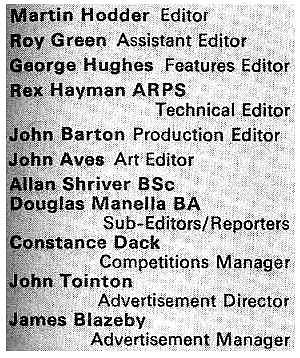 Editorial names list, 1st June 1977 |
 Editorial names list, 11th October 1980 |
|
Vic Blackman's son, Nigel, tells me his father wrote another book, entitled "Naff Off", being a negative reaction to life when his relationship with the Daily Express faultered. Nigel tells me the better one was "My Way With A camera", which properly reflects Vic's success in his career. Although absent from the editorial names lists shown here, David Williams was a Technical Reporter in the period 1980-1982, together with Bruce Black and Keith Nelson (whose names appear in the October 1980 editorial listing, above right). David also mentions another name, Stephen Bayley who was Technical Editor around that time. David describes Stephen as "a knowledgeable, albeit 'dramatic' Technical Editor of Amateur Photographer magazine, with an ability to drink a pint (of beer) at breakneck speed". The 21st August 1982 issue cost 50p. It showed yet another new editorial names list. Roy Green remained as Editor and a few previous names had gone, see below left. More new names joined the editorial team by January 1983. David Cocksedge and Alison Trapmore joined alongside John Wilmott as further Technical Reporters. Lawrence Court replaced Nigel Oakins as the Advertisement Manager. By April 1983, Martin Hodder's name had disappeared as Publishing Director (to be replaced by Richard Brock by April 1984) and in July 1983, Allen Shriver arrived as Editor-in-Chief. |
||
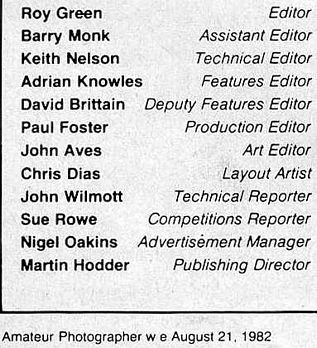 |
 Front cover, 1st June 1977 |
The name of Chris Dias, Layout Artist, disappeared by October 1983 and the name of Kate Garlick appeared in that editorial position by the start of 1984. By April 1984 Alison Trapmore had left and two new names arrived, Pippa Brooks and Richard Brook. Various job titles had also changed. The editorial name list in the 28th April 1984 edition was as below:  |
|
The 25th June 1983 edition was a special issue. Not only did it have a Zoom Lens Guide (10 pages, around 250 lenses, from 20-40mm up to 360-1200mm), but had the "First 3D Hologram Cover". The price had risen to 60p but the 3D issue had a substantial 98 pages (196 sides; includes the cover). An article by David Burder was entitled "The Amazing History of 3D". Click the link to download a copy. This explored 3D imaging from the Victorian obsession with black & white stereo card photographs looked at using a hand viewer, through the use of red/green spectacles permitting (in monochrome) 3D cine films and photographs, followed by viewing full colour 3D films and slides using polarising spectacles, followed by a Russian system that avoided the need for spectacle wearing by projecting onto a special screen composed of thousands of fine lines that reflected separate right eye & left eye images. It concludes with the new (at that time) Nimslo system (c.1982) which again required no spectacles, the corrugated (lenticular) plastic print surface itself providing different views to the right and left eyes. Holography is described as not being a competitor to traditional 3D but an exciting alternative. |
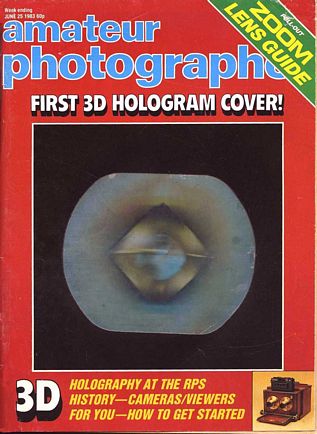 Front Cover, 25th June 1983 |
 The Hologram cover was produced by Advanced Holographics Ltd and embossed by Intra Plastics Ltd. The design was by John Aves. The hologram (entitled Crystal Creations') on the front cover....depicts the planet Earth inside a double-pyramid shape. In order to see the image in full 3D it has to be lit by a single spotlight, or by a beam from a projector. Viewed from the correct angle the full depth of this colourful 3D image can be seen. |
|
AP relocated from Dorset House (1970) to Fleet Street and then to Throwley Way, Sutton, Surrey, around 1973. |
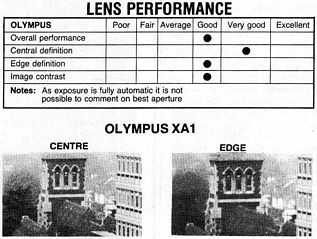 Lens testing using the St Nicholas church tower with a summary performance table, 21st August 1982 (see colour photo' of the tower, left) in a lens test, with no indication how it had been achieved. |
 Lens test chart and summary table, 26th March 1983 |
|
The relocation to Throwley Way made it inconvenient to continue using HQS Wellington as AP's lens testing subject (see top of this page and section 'The 1950s'). However, David Williams tells me that, despite this inconvenience, the use of HQS Wellington initially continued after AP's move out of London, until 1981 or maybe 1982. "The technical department had to take a camera or cameras and lenses in a gadget bag along with a tripod and travel from Surrey House in Sutton to Waterloo Station and then walk east of Waterloo Bridge along the South Bank of the Thames to the usual location opposite HQS Wellington. This took up to 90 minutes, depending on pubic transport. After the test shots we would then give the film—always the slow (ISO 50) high resolution Ilford Pan F—for processing to the photographic lab or do it ourselves. The AP office in Surrey House had a decent darkroom, which we used for testing enlargers, darkroom equipment, materials and processing chemicals, as well as for creating our own prints for tests or occasionally for darkroom features." So a new test subject was found, this being the upper tower section of St.Nicholas' church, Sutton. It was some 500m away from AP's Throwley Way office building, a similar distance as was previously Dorset House from the Thames. Chris Lees (Assistant Editor in 1987; see his 'photo near the top of this page and further notes lower down this page) has kindly provided a summary of why and how lens testing procedures changed between the times at Dorset House (HQS Wellington test subject) and subsequently at Throwley Way (1973), at Cheam (1986) and thereafter. Chris Lees explains: |
||
|
"(To photograph) HQS Wellington (across the Thames near Waterloo Bridge) required just three minutes' walk from Dorset House to the (South Bank) test location. In the days of fixed, prime lenses (rarely long telephotos), air quality and minuscule movement of the ship rarely forced a reshoot. Our reporters could run a film through the camera at all f-stops, shoot a few real-life images, then drop the film into the darkroom staff in time for a pub lunch with Victor Blackman! Far fewer lens tests were required in the Dorset House days, and there was less pressure to treat lens tests as urgent, so testing staff could afford to wait for the right conditions - sometimes months". "Once in Sutton, technical reporters soon tired of travelling the 90 minutes to the South Bank (as commented by David Williams, see above). St. Nicholas' church featured nice detail and was on AP's (relocated) doorstep. During this time, however, zoom lenses were becoming popular, increasing the number of test shots many fold; each lens required test shots at various focal lengths, all using the full range of 'f' stops. Also, lenses were landing on the desk throughout the year, causing issues with consistent lighting and atmospheric conditions. As a result, using a lens test chart became an inevitable and necessary fallback".
"Superzooms (eventually 28-200mm) became the fashion and were hailed as the 'only lens you'll ever need'. But they gave us a headache! Imagine shooting through all the 'f' stops at six different focal lengths. We'd often burn through four rolls of B&W and two rolls of Ektachrome, before starting all over again for a comparison test. Hence the return to the practicality of using indoor lens testing charts, enabling the tests to be completed without concerns over consistent lighting and atmospheric conditions". "The upside of using lens test charts was that lenses up to about 300mm focal length could be shot at an optimal distance of 50x their focal length, and we could organise product shots at the same time. By this time, we had literally thousands of prints to quickly compare and decide whether a lens was excellent, good, or indifferent. What's more, we got to know a lens and its foibles (such as lens flare and rotating filter threads) more intimately. Most importantly, as test shots could now take half a day, we completely removed lighting and atmospheric variables from the equation. But testing became quite tedious. The frustrations increased over time as camera companies started eliminating cable release threads and mirror locks, requiring repetitive use of the self timer. (On the plus side, I discovered that the mirror sometimes caused camera shake with long lenses at 1/30-1/60sec). Finally, I had to cut a hole in Alan McFadden's studio wall for the longer lenses. He never forgave me". "Modular Transfer Function (MTF) lens testing became popular with other publications. This was a test developed by lens designers as a modelling tool and involved sending the lens away to a lab, losing precious handling time. Results would come back as the now familiar graphs, better suited to the boardroom than the camera shop. While we seriously considered this approach, our pragmatism paid off; I received a panicked 'phone call from a rival editor when he found that they couldn't stop down the diaphragm on many new AF lenses (when not attached to a camera body). Rivals also suffered delays when independent manufacturers sent lenses with incompatible mounts. Besides, we discovered that widest and smallest apertures rarely, if ever, matched MTF results of the time, even with the most scrupulous of camera techniques (sometimes they were actually better, but usually worse). MTF testing is much improved now than it was in the late 1980s, but AP..." (preferred to retain their in-house procedure using lens test charts and their own technical team). On any day, one of AP's technical team would be testing something, viz: film comparisons, studio lighting, background stands, filter systems, even video cameras. Chris Lees' favourites were testing bags and tripods to destruction! A big bugbear were flashgun tests. Imagine running batteries to exhaustion, by setting off the flash 250 times. The upside of the tedious lens testing procedure was that it gave AP's technical team opportunity to bond with the studio and lab. staff, themselves all avid and experienced photographers. David Williams described a visit to 'Popular Photography' magazine, in New York, in 1984. "It was a monthly magazine and its circulation peaked at around 1 million at that time. Michelle Frank, the Technical Editor, showed me their testing laboratory, a well-equipped array for testing cameras and lenses which a British photographic magazine could have only dreamed of. They tested lenses using US Airforce targets with their tripods secured with sandbags, or such like, so there was no camera movement. This test was supplemented with others. I was impressed with their procedures. Popular Photography didn’t print bad reviews, though. If any equipment it tested didn’t make the grade it wasn’t mentioned in the publication.” "Popular Photography ceased publishing in 2017, citing the rise of smartphone-camera technology and its increasing ability to capture quality photos and video as the principal cause for its closure. Basically, people could take and share photos without any technical knowledge. Like its British equivalents, it had also lost dealer advertising and readers to the Internet and other consumer interests". |
||
|
A name that appeared in AP over a number of years, but never in the named editorial list, was Ron Spillman. His varied enjoyable contributions made him a firm favourite. Chris Lees explains: "Weekly, and even many Monthly, magazines have space for one or two regular reliable contributors. Vic Blackman and Ron Spillman were perfect examples of chalk and cheese: Vic with his entertaining 'hard edge', sometimes described as the magazine's 'whipping post', and Ron as the always-polite crowd pleaser. Both held retained freelance status and so didn't appear on the editorial list. An enjoyable and regular weekly part of AP since the 1950s had been the Readers' Questions page(s) and this had been omitted for a time. But it re-appeared towards the end of 1983 (maybe November ?) entitled "Ask Spillman". Chris suggests that Ron almost certainly will have pitched the idea of Readers' Questions re-appearing as "Ask Spillman". Ron Spillman's picture headed the pages and is reproduced here, right. He authored a book "The Complete Photographer" in 1990. I believe Ron died at his Shrewsbury home in late July 2003. "Ron was amiable and so became familiar to club members and enthusiasts. He became AP's 'goodwill ambassador' and represented AP at shows and exhibitions. He developed a front of house (and always squeaky clean) double act with a young Scottish model called Carol Smillie, who was spotted and had a successful TV career on 'Wheel of Fortune', 'Changing Rooms' etc". |
 Ron Spillman in 1983 and (below) in 1991. Carol Smillie |
 Centenary Year first cover, 7th January 1984 All covers during 1984 carried the news 'Centenary Year'. |
| During 1984, AP celebrated 100 years of its publication and included a reprint of the very first edition. Unfortunately, I don't own a copy to show here. | ||
|
1985 saw another price rise, to 65p, and a further change to the editorial names list (see far right; Dec 1985). The December 14th 1985 edition was labelled a 'Glamour Issue', but with the novelty of it also being in 3D, sold complete with a pair of (red/blue) 3D glasses. See cover, right.
Barry had joined as the Features Editor towards the end of the 1970s and was Assistant Editor by the early 1980s. His Deputy Editor, for a short time, was Kate Salway. In the December 1985 editiorial list, notice a new name, Chris Lees, as Technical Editor (see his 2017 photo near the head of this page). Chris was no stranger to the world of photo magazines, having worked for three years on 'Photography', '35mm Photographer' and 'Camera Choice', AP's sister monthly magazine. Chris joined AP as Deputy Technical Editor, working under Keith Nelson while Roy Green was still Editor. He became Technical Editor when Keith Nelson was tempted away to launch a 'Running' magazine for a rival publisher. Subsequently (by mid-1987) he rose through the ranks to become Assistant Editor. |
 Front Cover (3D image) 14th December 1985 |
 |
|
At 'Camera Choice', after Chris's move to AP, Lynne Barber took over his role, recruited by Stephen Bayley. Then when 'Camera Choice' closed, Lynne also went to work on AP. Chris Lees continues the
story: |
||
|
"The technical department was understaffed for a while, but was strengthened to four members. Keith Nelson hired Lynne Barber, a very talented journalist, formerly of 'Camera Choice', and I later hired David Daye with his encyclopaedic knowledge of equipment and excellent eye for detail. David Cocksedge, another avid runner, left around the same time as Keith Nelson, and another upcoming name - Keith Wilson (see his photo, below, right) - switched from the production department to the technical team." Lynne Barber left AP in 1988 to join Practical Photography, but that magazine sadly ceased publication on 2nd June 2020.
"We refreshed the look of the magazine, computerised and expanded the equipment guides, offered lots of free supplements and introduced offshoot publications, viz: Camera Buyer, Camera 88 and Camera 89 Journals. I think my highlight was spending long hours in the photo studio with the amazing Alan McFaden, developing pioneering ways to display product shots, techniques still in use to this day." Between December 1985 and March 1987 (maybe May 1986), AP relocated again, this time to: Prospect House, 9-13 Ewell Road, Cheam, Surrey, SM1 4QQ. It had been at Surrey House, Sutton, Surrey, for around 13 years. Having climbed from a certified Audit Bureau Circulation of 91,442 in April 1964 (see above), the circulation of Amateur Photographer peaked in 1981-1982, when it had an ABC of 110,000 copies—its average weekly sale over 12 months. Since then, it had been in decline. Camera equipment technology (until digital) had little new to offer—autofocus and wide-range focal length zoom lenses being two of the last big developments—and consumer interest had moved towards home computers, including video games. The effect was less advertising revenue for photographic magazines. David Williams comments: "AP’s circulation was in decline... Bright sparks at both Haymarket, which published Camera Weekly, and Reed, publisher of Amateur Photographer, hatched a plan to swap a motoring magazine for a photographic title so that the two companies could strengthen their portfolios. Reed had expected the move to increase sales of Amateur Photographer, as it was ceasing publication of a competitive weekly magazine, and adding 'What Camera' to its stable. At the same time the editorial staff of Reed’s titles had become a mix of Reed and Haymarket, with 'Camera Weekly' Editor George Hughes appointed as the new Editor-In-Chief of Amateur Photographer." So it was that the AP's publishing
group Reed (owners of IPC) acquired the monthly magazine
'What Camera' (including 'Camera Weekly' formerly 'What Camera
Weekly', which had already been swallowed up by 'What
Camera'). 'What Camera' initially continued as a monthly,
but subsequently became incorporated into Amateur Photographer.
The final issue of 'What Camera' appeared in September 1990.
Chris Lees was at AP throughout this period of change, including
the time, around September 1989 when, as Chris puts it, Barry
Monk was sitting in the Editor's chair on a Friday, and George
Hughes the following Monday. George had temporarily returned
to AP as Editor-in-Chief as a result of Amateur Photographer
acquiring the Haymarket magazine 'What Camera'. Several other
'big hitters' on 'What Camera' joined AP, these included Mike
Maloney - see lower down - and Heather Angel. David Williams takes up the story. "I don’t know what happened at Haymarket (after the swap of magazine titles), but the Reed publishing company certainly didn’t notice any indication that the readers of 'Camera Weekly’ had moved to AP — AP's circulation continued to decline.” |
||
|
The above story of magazine titles being exchanged, together with editorial staff changes, is a somewhat confusing picture. However, in Amateur Photographer dated 12th August 1989, Keith Wilson had regained the title of Editor, but under Editor-in-Chief George Hughes. Keith writes (in his 'Comment' column) "This time last year (i.e. August 1988) I left AP to edit this company's new monthly photographic magazine 'What Camera'. Now that 'What Camera' is successfully established on the market, I'm thrilled to be back at the helm of the world's most read photographic magazine". Joël Lacey comments "George Hughes left AP for the second, and final, time after Keith Wilson came (back) on board and (Keith) didn’t want the metaphorical 'Banquo’s ghost' interfering with his work. George Hughes (after leaving AP - maybe at the end of 1990) briefly worked for 'Video Camera' magazine before disappearing off the media radar". David Williams suggests "George Hughes' management style didn’t fit with Reed-Prospect Magazines. Eventually (by the end of 1990), Keith Wilson took complete editorial control and George Hughes went on to edit 'Video Camera' before turning freelance shortly afterwards”. Chris George became Deputy Editor (by September 1990, or earlier; see below, right). Chris George wrote a weekly page entitled 'Basically Speaking'. |
||
 |
 |
  |
|
AP announced the arrival of a new columnist in its 14th December 1985 issue who (it was planned) was to write a weekly page of personal comment, bearing his name, 'Joe Partridge' (Joe was already a columnist for 'Camera Weekly' doing 'Patridge's page'). But none of my (few) subsequent issues have further pages from Joe Partridge, so perhaps things didn't work out as intended. In 1989 the price of AP reached £1. |
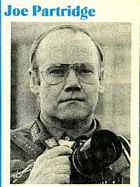 December 1985 |
|
|
Digital Technology on the Horizon
But new, filmless, picture capturing technology was also on its way by the mid-1980s. Initially however, the technology used was the same as in a TV video recorder, storing an analogue signal onto a magnetic medium. The term 'digital' became synonymous with electronic imaging, but true digital cameras, as distinct from still video, didn't appear for sale until the early 1990s. An excellent history of electronic imaging, video through to digital, by Richard Trenholm, dated 5th November 2007, is available on the website: https://www.cnet.com/news/photos-the-history-of-the-digital-camera. The text and illustrations are transcribed here (click link and select 'save link as' option). As Chris Lees says, "The
electronic image revolution was a thinly veiled secret to those
in the business. Amateur Photographer for 19th September 1981
carried a news scoop article entitled: "More information was revealed to the UK Press in 1982 at 'The Ritz', London, where Akio Morita, Sony's co-founder, showed off a non-working prototype digital stills camera, the Sony Mavica (MAgnetic VIdeo CAmera), though this particular design was never commercialised. Akio Morita had the idea (together with video cameras) decades before while developing magnetic tape, but his development of the digital video disk (as in Sony's Digital Walkman) unlocked the potential." "Almost all the camera and film companies were planning for the digital revolution, and began feeding photo journalists snippets of information at Photokina every odd-numbered year." "Kodak were already secretly prototyping digital print processors and told us that when camera sensors reached 10MPixels, most people wouldn't be able to discern image noise from film grain, while 17MPixels would be as good as, or better than, (colour) negative film! Ironic really - Kodak, the giant of the film world, was effectively killed off by its own digital developments. Meanwhile, Akio Morita died before seeing Sony's DSLRs become the award winners they are today." Above is a picture of Akio Morita, Sony Chairman and Chief Executive Officer, showing the revolutionary 'Mavica' video still camera and 'Mavipak' magnetic disk with a capacity for 50 colour images (at the resolution of the early Mavica). David Williams attended the launch of the Sony Mavica in 1982 as 'Camera Choice’ Deputy Editor. Also present was AP’s Technical Reporter, John Wilmott, who Stephen Bayley had recruited. David remembers discussing with John the absurdity of comparing electronic images with film. "I can’t recall either of us saying a camera like the Mavica would never catch on, but we couldn’t see film losing out to digital images, bearing in mind digital resolution was so poor compared with the chemical process of film." Wikipedia tells us that from the late 1990s, Sony released a number of cameras based on digital (rather than analog) technology under the "Digital Mavica", "FD Mavica" and "CD Mavica" brands. The earliest of these digital models recorded onto 3.5" 1.4 MB HD floppy disks in computer-readable DOS format. Subsequently the floppy-disk (FD) Mavicas began to be Memory Stick compatible and finally (from 2000) the CD Mavica series appeared, which used 8 cm CD-R/CD-RW media. The last of the Mavica FD series (also equipped to use the proprietary Sony Memory Stick and having a mini-USB socket for connection to a computer), appeared in 2002. This was the Mavica MVC-FD200, having a digital resolution of 2 MPixels. It is believed to have cost around 500US$ on the American market and probably (?) near £500 in the UK. However, by June 2005 an advertisement in Amateur Photographer (Park Cameras, p87) had them being sold for just £219. To see some images of this final FD series Mavica, click here. |
||
|
In the regular 'NewsView'
pages of the 21st March 1987 issue, a significant short article
appeared of which few people at that time, outside of photography
journalism, would have realised the significance. Another first for a filmless camera is that it incorporates playback capability - in other words, all that is required for recorded images to be reproduced on a TV's video channel, is a connecting lead. The Casio VS-101 uses a video floppy disk for 50-shot recording and weighs only 960g with its rechargeable battery. Basic features are a 2/3rd inch, 280,000 pixel (picture element) CCD image sensor, 11mm f/2.8 fixed focus lens (45mm focal length in 35mm format), programmed auto exposure, a focal plane shutter speeded 5sec - 1/1,000sec, consecutive picture taking at 5fps, and an LCD display. Although the camera has been
developed as an instant camera to project images onto colour
TV screens, a hard copy printer (at around 200,000 yen - £820
or less), transmitter and other accessories, are being developed.
Planned monthly camera production is 10,000 units initially,
a high figure for such a new and innovatory product. The Casio
camera is said to have been produced by a camera maker, but the
name has not been disclosed. Whether electronic systems take off sooner rather than later depends to a large extent on whether the consumer will be satisfied with still images reproduced on a TV screen. A hard copy printer of sufficient quality has not yet been developed by Casio, and the launch of the Casio VS-101 only serves to confirm the Japanese philosophy that the TV set will be the medium for viewing these images. However, Kodak believes that the system will not be fully acceptable to the consumer until good quality hard copy prints are available which, at this stage, seems some way off". Note: that the above refers to a camera capable of recording just 280,000pixels = 0.28MPixels and used analogue, not digital, video technology. It took 10 years more before 1MP digital resolution was attainable at 'acceptable' cost. One of the first was the Olympus Camedia C-1400L, launched in 1997, price £1,300 in the UK (plus a 3.3v Smart Media memory card). This fixed-lens digital single-lens reflex camera was equipped with a high-performance optical 3x zoom lens and could record 1.31 MP (1280x1024). The future had arrived and the MegaPixel race had begun. By mid-1999, the Camedia C-1400L had been surpassed to the extent it was being sold off mail order for £499 under the banner "Digital Megadeal!! Last Few!!". Such was the pace of change. Nikon broke through bthe 2MPixel frontier in 1999 with their 2.11MPixel Coolpix950 and 700 cameras followed in 200 by the CoolPix800 (priced around £600 with a 2:1 fixed zoom lens). Chris Lees comments "If 16 years (1981-1997) seems a long time for one of AP's scoops to pay off, spare a thought for Sony's Akio Morita: he had a vision of 'filmless still and movie cameras' a full five decades earlier!" |
||
|
The 1990s Joël comments "I had the interview with George Hughes
and Eric Verdon-Roe (CW’s publisher and a member of the
Verdon-Roe family of WW1 AVRO aeroplane fame) after George had taken
me to the pub' wth the magazine’s staff for a few lunchtime
pints (which was as much a standard part of the interview process
as it was later to be of the job). I didn’t get the job
and I don't remember getting home!" The September 1990 issue of AP (as pre-1975) had its cover glued onto a flat spine. This once more enabled the magazine to show useful date and content information down its spine, easily viewable when filed. Its price had risen again, to £1.10p During late 1990 or early 1991,
Amateur Photographer incorporated the magazines "What Camera"
and "Camera Weekly". Probably as a consequence of this,
by autumn 1990 Amateur Photographer was proclaiming itself, along
the top of its front cover, "The World's A new contributor appeared in 1991, being Mike Maloney who wrote "Mike Maloney's Picture Clinic". In his weekly column, Mike made comment on reader's photographs, in an amusing, semi-abusive, style. In some ways a replacement for the old Ricardo critique, but in an altogether up-to-date, brusque and no-nonsense manner. He went for eye-catching images, closely cropped to add impact. Pictorialism was no longer the hallmark of modern photography. This site records "Mike was chief photographer for Mirror Group Newspapers before turning freelance in 2002. During a career spanning more than 30 years, Dr. Mike Maloney OBE has won 107 major photographic honours, including being voted 'Press Photographer of the Year' three times". |
 Above is at 18th May 1991 By July 1991, the Publishing Director was Sylvia Auton |
|
|
The 23rd February 1991 edition, in its 'News' pages, carried an announcement "Nikon Goes Electronic". "....Nikon is moving its production concentration away from still cameras and is expanding its electronic imaging division. ....described as a 'springboard for the future'". "Sources close to Nikon have revealed there are plans to promote an electronic imaging system made up of a 35mm colour scanner, colour printer, personal computer and optomagnetic disc drive". The same edition carried the news that Kodak's Photo CD system would be on view to the public for the first time at Earl's Court, London, (AP's Photography and Video 91 show) from 28th March to 1st April.
The same edition had another new name in the editorial list; Dr Stewart Bell (sadly died on 9th December 2003). He was to gain much respect from readers for his knowledge on lenses and all things optical. At this time he received the title of Technical Consultant, though had written for AP previously. In the 8th September 1990 edition he tested a new autofocus lens from Angenieux. For a full editorial names list as it appeared in the 18th May 1991 edition, see right. The 22nd June 1991 edition carried an obituary to Reg Mason, AP's Art Editor from 1946, Editor from 1963 to 1976. |
||
 R (Reg) H Mason obituary, 22nd June 1991
|
 Front cover, 6th July 1991 |
|
|
By October 1991, the price had increased to £1.20p and the magazine had again reverted to a simple stapling of the pages and cover along their spine, though remained at 114 sides (57 pages) plus cover. The first inside page no longer showed the index and list of editorial names etc, but was devoted to 'Pic Of The Week' (see far right). The next two facing pages were the 'This Week' index, with its editorial names. The Classified Advertisement Manager was then Sally Collins. Jack Close had joined the Columnists and was on the search for the Ugliest Town in the UK ! A Managing Director had been appointed, named Mike Tudball. Fuji, Canon & Yashica were named in the News section regarding their involvement in digital imaging, while the Photo Marketing Association (PMA) had set up a Department of Environmental Activities, including aspects of worker safety. The same edition had a pull-out "Step by Step Guide to Perfect Pictures" supplement, this one devoted to Cats! These Guides became regular insertions. The 23rd November edition had a "Guide to Perfect Pictures - Football". |
 Lens test charts from 23 November 1991 edition The four lines per chart are centre & edge definition at the two extremes of the zoom range. |
 Pic of the Week, 16th November 1991 |
|
Importantly, the 23rd November edition 'News' carried the announcement that the Daily Mail had become the first UK paper to publish a digital photo', taken using "the new Kodak Digital Camera System (DCS) which doesn't require film". The Kodak digital back, giving 1.3MP, was fitted to a Nikon F3. Images were stored in a separate shoulder carried unit with a hard disk, from whence they could be transferred into a Mac computer or sent direct to picture desks by telephone & modem. Stewart Bell explained his test results from wideangle AF zooms (20-35mm) of Sigma and Tokina manufacture (see example lens test, above right), and then had a further three pages contemplating and testing power zoom lenses from Pentax and Minolta (a convenient aid or an unneeded battery drain). Joël Lacey also included comment. In the 16th November edition, Technical Editor Justin Mullins had compared four entry level autofocus slrs plus he tested two Canon 'compacts'.
Joël Lacey comments
"much credit should
go to Alan McFaden. |
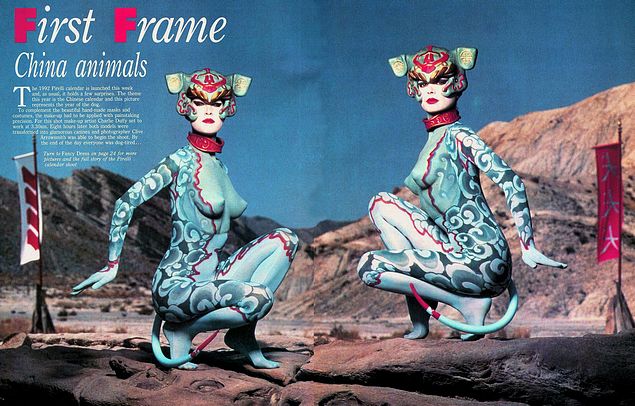 A striking double page image from the 16th November 1991 edition. A 1992 Pirelli calendar preview. A Chinese theme but shot on the Spanish Costa del Sol. |
|
|
"He was responsible for a good many covers over the years too. He handled every camera we tested so I would guess he has handled more cameras than pretty much anyone on earth! If anyone were to write the definitive history of Amateur Photographer it would be Alan". "Whenever anyone came up with a new idea for a feature, or invented a new photograhic technique, we’d often send them over to see Alan who’d say: ‘Oh yes, that is a good idea... in fact so good that we tried it in 19XX,’ and then he’d get the relevant magazine out and the person with the new idea would return to the office duly chastened." |
||
|
Kodak's Photo CD system was given new impetus by Apple announcing support via a version of its Quick Time for image compression, enabling images to be stored on a CD and imported into graphic software running on an Apple desktop computer. The 18th April 1992 edition, and subsequent, had 'grown' a little, to A4 size. Equipment News mentioned an innovation from Canon and Zeiss, regarding the elimination of camera shake. This technology is now (2016) almost universally applied in digital cameras. The 9th May 1992 edition, in the News section, offered four AP readers the opportunity to test the "Kodak's imaging system of the future - Photo CD". Everyone else would have to wait until its official launch in September 1992. The same News contained a brief report of Canon and Sony announcing still video cameras using 2inch floppy disks to store images. The Canon Model RC-570 cost £1,600 while the Sony Mavica 7000 cost £5,000, aimed at pros. Also, Gwent College of Higher Education had announced a photographic degree course that included computers and electronic imaging. Chris George was writing a Technique Masterclass rather than his previous 'Basically speaking'. |
 Front cover, 27th March 1993 |
 Editorial names, March 1993 Note the European Awards Panel logo. Similar had been displayed since autumn 1991. |
|
Joël Lacey comments "Ron Spillman left us to join Practical Photography for a year at a much higher rate (but they didn’t renew his column after the first year). I set up 'Ask the Experts' as these were the people who Ron had been sending his queries to, for answering, for years anyway, and I thought it fairer that they get the glory". Questions were divided among 'Experts' Peter Sutherhurst of Kodak, Tony Shapps (widescreen, 3D, AV and cine), Stewart Bell of AP (lenses & optics), Stewart Gibson (freelancing), Dave Slade of Jessops (classic cameras), Robin Fry of AP (legal matters), Joël Lacey of AP (processing & darkoom) and Keith Wilson AP Editor (general problem solving). Readers letters often carried
opposing views about whether some of AP's cover and articles
were in questionable taste. It was unfairly compared to 'top
shelf' magazines by the more prudish. No doubt the cover to the
27th March 1993 edition stoked this controversy, see above, right.
The price had risen to £1.25p. A break in my AP collection means a fast-forward to Saturday 6th July 1996. By that date, David Bailey had joined AP's Columnists, giving 'The Expert's View'. There were several editorial name changes, so another names list is shown, far right. The price of AP had risen to £1.50p |
 6th July 1996 |
 6th July 1996 and much the same by mid-1998 |
|
'Pic of the Week' had disappeared and the first editorial pages were now pages 4&5. Keith Wilson was still Editor and had a column devoted to 'Speaking Personally'. The magazine listed 'Our Guarantee to Readers' as a series of 9 bullet points, see right, above. APS (the new film-based Advanced Photo System) had been announced by Kodak, Fujifilm, Minolta, Nikon, Canon and others on 1st February 1996 (fully described in 10th February AP edition), so that by July 1996 advertisements and camera tests were appearing. But it was too late to revitalise the 'snap shot' market, since digital was already gaining ground. In January 2004, Kodak announced it was ceasing APS camera production. Fuji and Kodak, the last two manufacturers of APS film, discontinued production in 2011. The cover of the 6th July 1996 edition is shown right and the faces of more of the editorial team can be seen far right. Looking at the cover, I find it fascinating, yet sad, that expensive film cameras, such as the Contax AX costing £1,900, were still being developed and sold when they would be obsolete within little more than 10 years. The 3rd January 1998 saw AP priced at £1.60p David Royston Bailey was given a special 6-page article in celebration of him having passed the age of 60 on 2nd January. A side column gave a chronology of his life and loves. |
 front cover, 6th July 1996 |
 Some of the editorial staff in the above list. |
|
"When Keith Wilson left, Garry Coward-Williams arrived from 'Cage & Aviary Birds' as the new Editor (1998-2007) and, as is often the case when a new chief arrives, the guard was changed. Steve Fairclough left AP to be Editor of 'Stamp Magazine', 'Football Collector' and 'Hi-Fi News', before going off to join Red Dot, who did all of Canon’s professional communications. "Features Editor, Terry Hope (known as the Peter Pan of photography owing to his eternally youthful looks), went freelance, as did Cathy Joseph". |
||
|
In news 'This week', edited by Lee Gale, Minolta had launched a film scanner for 35mm and APS negatives, scanning at 2438dpi (8.2MP) in the 35mm format. It cost £399, plus £75 for the APS adapter. Software was available for the PC (Windows 95) and Macintosh (OS 7.1-7.5), communicating via a SCSI interface. An article by Joël Lacey examined "The future of APS", with subsequent articles promising to consider the future of 35mm film and then the future world of digital imaging. Although reasonably upbeat, there is no doubt that the advance of digital technology was becoming a concern for the success of APS, since both were thought to be in competition for the snapshot market. For the serious enthusiast, 35mm film, used in quality cameras, was still thought unlikely to (ever ?) be usurped when it came to ultimate quality of result. A whole page was devoted to listing digital cameras, with resolutions starting to approach 2MP, albeit at prices in the £2,000 to £3,000 range. By 2nd May 1998, the cost of
AP had risen to £1.65. In the 11th July 1998 edition,
Sanyo announced a new digital still camera, their VPC-G250, that
could also shoot and store four 5 second bursts of video,
but had a resolution of only 350,000 pixels, despite costing
£450. Sanyo's UK marketing manager, Peter Eldon claimed "Within a
very short time, the consumer camera market will be dominated
by digital cameras, marking the end of mass market, film based,
photography as we know it". The Cottingley Fairies story, that fooled the world, including Sir Arthur Conan Doyle, into believing fairies really do exist, ran for over 60 years (1917 to 1983). The cousins Elsie Wright and Frances Griffiths took the photographs of cut-outs they made and painted using a 1917 Midg drop-plate box model and a German-made Cameo folding plate camera. With Cottingly being just a few miles from Bradford, it was fitting that the cameras and other memorabilia should go to the Bradford National Museum of Photography, Film and Television. The cameras were owned by Geoffrey Crawley who had previously purchased them to save them going to the US. The 11th July 1998 issue included a test of a Canon Bubblejet A4 digital image printer, priced £317. This was a 'top of the range' printer but a previous model had been reviewed within the previous 2 months. AP reported that the technology didn't (at that time) produce images with a completely continuous tone (1200x600 dpi resolution). But AP had tested one that could, in their 30th August 1997 edition. The Alps Masterpiece printer could effectively join the individual inkjet dots by overlaying them with a varnish, that blended them together. Possibly priced around £500 (quoted as 750$ in the US), AP voted it 'Digital Accessory of the Year' 1998. |
||
|
Readers were voicing criticism of the APS film and camera system, claiming lower quality prints due to the smaller negative area (compared to 35mm) and the image cropping required to provide the three print formats. The processing cost was also much higher than 35mm. Reader Clive Kenyon, in the 'Back Chat' column at the end of the magazine, compared the availability of £2.99 processing for 35mm colour negative film with 'around £12' for APS. Notwithstanding this rebuke from certain readers, the 31st July edition tested three new APS compacts from Canon (IXUS II), Minolta (Vectis 2000) and Nikon (Nuvio S), and were happy with them all, though ultimately favouring the Canon. 1999 saw the first fully integrated digital SLR designed from the ground up, rather than a digital bolt-on to a 35mm film SLR. The Nikon D1 featured a 2.7MPixel sensor and 4.5fps shooting – a respectable speed even today. See the 'What Digital Camera' round-up of the 16 digital cameras that changed the world. Consumer compact digital cameras had just topped 2MPixel resolution. Despite the advertisements for compact digital cameras, plus film and negative scanners from Minolta (Dimage) and Nikon (Cool Scan), the editiorial emphasis was still on film cameras. There had been recent launches of sophisticated AF (auto-focus) film SLRs by Minolta, Canon and Nikon, but the cameras being tested in the 12th June 1999 issue were basic manual focus 35mm SLR models from Cosina (C3; £170) and Vivitar (V4000; £130) both fitted with 35-70mm f3.5-4.8 zoom lenses. A new inclusion in the 'This Week' news section was 'Website of the Week', featuring sites with photographic content or special interest. The test of a Polaroid SprintScan film scanner in the 31st July edition (35mm and APS only) giving 4,000ppi resolution (60Mb file size) was greeted with much enthusiasm, though at £1,761 it was noted to be expensive. The end of the review showed good foresight. The reviewer (Joël Lacey) referred to scanning a negative taken underwater that had hitherto resisted any attempt at conventional printing, due to its "extraordinarily low contrast". "Two minutes after scanning, and after a quick 'whirl' in Photoshop 5, I (the reviewer) had an image which looked as if it had been shot in daylight and printed (by digital inkjet) perfectly". Joël concluded by saying "Scary stuff indeed for the chemical printing world". |
||
|
The Millenium Year (2000) Mike Maloney was still doing his weekly column commenting on readers' pictures, but with less 'mauling' than previous. He was using a more gentle and helpful tone than his previous out-spoken criticism, more an updated 'Ricardo'. The Amateur Photographer 'Help' Team, continued to answer readers' queries. Most remained as in early 1993, but a few new names and faces appeared, see right. The magazine was still very much film based (a 20 roll assorted pack of Kodak film, worth more than £120, was the prize to each reader sending a letter that was published in the 'Letters' pages. And a Leica M6 kit of camera body and lenses, worth £6,244, was the grand prize in the 'Amateur Photographer of the Year' competition. However, there was also plenty of digital comment, reviews and adverts. 'This Week' reported that a Beginners digital imaging video entitled 'Getting Started in Digital Imaging' was available from Marrutt Digital for £23 (in VHS tape format). And Epson had taken the wraps off two professional scanners, the Expression 1600 and 1600Pro, print and film flatbed scanners. Both delivered 1600x3200dpi resolution, and cost £750 and £985 respectively. Kodak claimed that an increased number of affordable digital cameras was helping to boost film sales. They justified this by saying "people are now getting more into photography and taking more pictures". Kodak spokesman Paul Allen announced that film use was partly driven by digital. Kodak advertised a 3.3MPixel DC290 camera which AP tested in December 1999 reporting "Handling and image quality are brilliant ..... a super bit of kit". |
 |
 Notice a name in the above
list, the Editor's PA, Christine Lay. |
|
AP tested the Nikon CoolPix 800, a "mid-range consumer digital camera" (with others being the 700 and the 950, released in 1999). Priced at £600 with a 2.11MPixel resolution and 2x optical zoom. AP concluded "....pocketability in digital cameras plus (relatively for a digital camera) decent image quality, has been sorely lacking - until now". They voted it 'worth its price'. A Photoshop article showed how redeye could be eliminated within digital images. The 14th October 2000 issue
continued the theme. Essentially AP remained a film camera magazine
appealing to high end, top quality, film camera fans, but conceding
that digital was now an affordable alternative for the mass market
(maybe meaning the 'snapshot' market). Japanese exports of APS cameras had 'nose-dived' 75% on the year previous. However, 35mm film sales remained buoyant and Fuji announced that it had expanded its range of Superia print film. AP tested the new Fuji ISO 400 Provia 400F transparency film, ".....a welcome addition to the photographer's armoury". The cover of the 5th February 2000 edition is shown to the right. The cover price of AP rose
to £1.85 by February 2002. |
 |
|
|
The 25th June 2005 edition celebrated the 80th Anniversary of an AP camera test on 27th May 1925, "....only a few weeks after its debut at the Leipzig Spring Fair, AP tested a new camera from the microscope manufacturers E.Leitz". The review started, "This is a camera of decidely novel design..." The camera was, of course, the original Leica, invented by Oskar Barnack. The reason for wishing to include this mid-2005 edition is that there had been a technology revolution during the intervening 5 years. The editorial content cannot be used to judge the magazine, since it naturally discussed the Leica camera, but the 'This Week' news items, and many of the commercial advertisements, are concentrated on digital cameras, printers and scanners. Kodak had announced their intention to discontinue their DCS full frame (35mm) sensor slrs (14MP), even though, with Nikon and Canon lens fittings, the latest of these were only launched in 2004. Camera prices had started falling, such that 4 to 5MP zoom compacts by Nikon and Canon were available for below £200. Newer models from all manufacturers were featuring 6 to 8MPixel sensors. Prices fell further over the next few years; I purchased a Canon PowerShot A560 4x zoom compact, with 7.1MPixels, for £60 from Argos in November 2008 ! It still (2016) gets regular use and works perfectly - and has an eye-level zoom viewfinder as well as its rear screen. The editorial names list is shown far right. Damien Demolder had become Deputy Editor under Editor Garry Coward-Williams. Mike Maloney, Stewart Bell, David Bailey and Joël Lacey (to name just four) were no longer listed as contributors. But by then Roger Hicks was occupying the back (inside) page with his "A matter of opinion", always a good read, I find. The magazine cost £2, still A4 in size and had 116 sides (58 pages) including the cover. Cover prices continued to slowly rise, viz: £2.10 by September 2005, £2.15 by August 2006, £2.20 by December 2007 and £3.50 for the double Christmas issue of 22nd and 29th December 2007. |
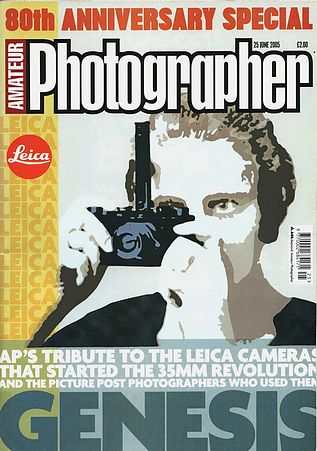 Front cover, 25th June 2005 The 80th Anniversary since AP tested the first Leica .jpg) |
.jpg) Editorial names list, 25th June 2005 |
|
By Spring 2008 the cover price
was £2.25 and by late 2008 it was £2.30. By July
2009 it had risen again, to £2.40. In April 2011 AP cost £2.60
and was £2.70 by September 2012. In April 2013 the cover
price was £2.75 and by November it was £2.80. By May 2014 it cost £2.85
and by August 2014 it cost £2.95. |
||
|
The December 2016 Christmas
'Bumper Issue' covered two weeks, Saturday 17th and 24th December.
It contained 116 pages (sides), including the covers. Its price
was £3.99 for this double issue edition. The cover is shown
to the right. Its size became smaller than A4, around 200mm by
290mm. The more normal
weekly cover price remained at £2.99. Nigel Atherton became Editor of AP in 2013 and (in March 2023) still remains in post. Nigel e-mailed to tell me "I joined AP in 1994 and have worked either on AP or its former sister title 'What Digital Camera' ever since. I started as a Technique Writer and eventually succeeded Terry Hope as Features Editor. At that time AP was under the Editorship of Garry Coward Williams. In 2002 I became Editor of AP's monthly sister title 'What Digital Camera'. Nigel also told me "Garry Coward Williams was replaced as Editor by the then Technical Editor Damien Demolder in 2007, and I then replaced Damien as Editor in 2013, initially as Editor of both AP and 'What Digital Camera' until the latter ceased publication in 2016". An Editorial listing appears to the far right.
AP introduced the tributes
pages as follows: No other journalist in the UK worried the industry's spokespeople as much as Chris. One PR told us that whenever they saw a call coming in from him, they were terrified. This makes him sound like a tyrant. He wasn't. Instead, Chris was quiet, modest and very well liked by all who were privileged to know him". Ending on a happier note, AP magazine remains the best photographic magazine on the bookstalls, having outlived so many rivals. But the transition to digital photography is virtually complete. Film photography continues to receive the occasional mention, but the content is now very predominantly, and inevitably, digital. In some ways the 'digitalisation' of the magazine's content is emphasised by the readers' letters (readers write) pages now being named 'Inbox', with most correspondence being received by email. |
 Front Cover, Christmas 2016 Photo' by Elena Paraskeva, AP winner of reader's entries for the cover picture. .jpg) |
.jpg) Editorial names list, 17-24th December 2016 |
|
By March 2023, the cover price of Amateur Photographer had risen to £3.99 though the 14th March issue was a 'Premium Edition' costing £5.49. It had 118 pages (sides) in total. This edition contained a 32-page pull-out entitled 'Travel Special' which attracted me to buy the magazine because it offered advice on light weight 'mirror-less' camera and lens kits, plus advice on mobile phones best suited to quality 'on the go' travel photography. Nigel Atherton, Group Editor (see his picture above), contributed an article describing his experiences with the Olympus OM-5 camera and lenses during his travels around South Africa. Later in the magazine, I was intrigued to read, under 'Tech Talk', a short (too short, in my opinion) review by John Wade of the 1960s analogue slr camera, the Voigtländer Ultramatic. What especially caught my eye was the picture of the Ultramatic fitted with the "world's first commercially successful zoom lens" the Zoomar. Covering just 36 to 82mm focal length range yet weighing 1.1kg, it wouldn't be on any one's Christmas present list nowadays, but was revolutionary back in 1959. It was produced in West Germany, though Wikipedia tells us it was "created by optical engineer Frank G. Back as an outgrowth of his research on viewfinders and variable focal length projectors for the United States military". In the AP 'Camera Guide' issue for 8th June 1960, the f2.8 Zoomar (distributed by Johnsons of Hendon) cost £218.11s, maybe the equivalent of £6,000 at the end of 2022, see here. I recall reading the original Amateur Photographer test of this lens in conjunction with the Voigtländer Bessamatic body (see below from the 8th June 1960 Camera Guide; unfortunately, I don't have a copy of the actual test). I remember being unimpressed by the results. The test report showed the usual (at that time) series of centre and edge images from 16 x 20 ins prints, at various apertures and focal lengths, of the test subject HQS Wellington (for more on the choice of HQS Wellington as a test subject, see top of this web page and 'The 1950s'). The Zoomar test images certainly weren't up to the standard of the magnificent Voigtländer prime lenses; the 50mm f2.8 Color Skopar, 35mm f3.4 Skoparex and 135mm f4 Super Dynarex. Not that I thought I'd ever have the money to own anything so sophistication, regardless of lens choice. It was just youthful day dreaming.  Someone has to be first, and Voigtländer should be congratulated on 'taking the plunge' and introducing a zoom lens for their 35mm slr camera. The Zoomar wasn't optically impressive by modern standards, but was well ahead of its time in 1959. It began a trend that has now been refined, using aspheric lens components, to an optical quality that suits all but the most critical still photography. Below are pictures of the Bessamatic camera and Zoomar lens, as photographed at the Wolverhampton Camera Fair, Sunday 3rd December 2023. Thanks for permission to take these pictures, Paula. |
 Front Cover for 14th March 2023 Cover picture by Philip Lee Harvey, Ambosell, Kenya.  Travel Supplement in this Premium Edition |
 Editorial names list, March 2023   |
.jpg) |
.jpg) |
.jpg) |
|
|
||
|
|
||
 Chris
Lees joined AP in 1985 and rose through the ranks to become Assistant
Editor.
Chris
Lees joined AP in 1985 and rose through the ranks to become Assistant
Editor.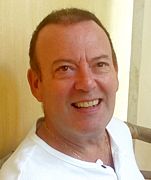 David
Williams has e-mailed
(April 2018) to tell me he worked for AP from 1980-1982, during
which time he was a Technical Reporter together with Bruce Black
and Keith Nelson; Stephen Bayley was Technical Editor. In 1982,
Stephen Bayley left AP to be Editor of a new magazine called
'Camera Choice', and David left AP shortly thereafter to join
as Deputy Editor. Chris Lees and Lynne Barber (now, Nov.2020,
Lynne Maxwell) both worked on 'Camera Choice' before moving onto
AP’s technical team. Tony March was the designer of 'Camera
Choice' and joined Amateur Photographer where he worked for a
number of years.
David
Williams has e-mailed
(April 2018) to tell me he worked for AP from 1980-1982, during
which time he was a Technical Reporter together with Bruce Black
and Keith Nelson; Stephen Bayley was Technical Editor. In 1982,
Stephen Bayley left AP to be Editor of a new magazine called
'Camera Choice', and David left AP shortly thereafter to join
as Deputy Editor. Chris Lees and Lynne Barber (now, Nov.2020,
Lynne Maxwell) both worked on 'Camera Choice' before moving onto
AP’s technical team. Tony March was the designer of 'Camera
Choice' and joined Amateur Photographer where he worked for a
number of years.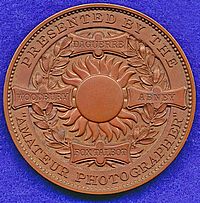 photographs
taken by amateurs.
photographs
taken by amateurs.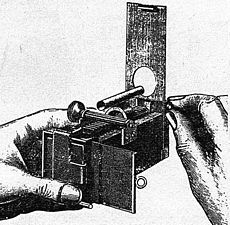 MARION'S MINIATURE CAMERA.
MARION'S MINIATURE CAMERA. A Federation supplement devoted to
the work of the photographic 'Federations and Unions' was started
and a new "A.P." plaque was introduced as an award
in the competitions. This was from a model by Michael Biro, a
Hungarian sculptor, and was the prize-winning design in a competition
instituted for the purpose by "The Studio".
A Federation supplement devoted to
the work of the photographic 'Federations and Unions' was started
and a new "A.P." plaque was introduced as an award
in the competitions. This was from a model by Michael Biro, a
Hungarian sculptor, and was the prize-winning design in a competition
instituted for the purpose by "The Studio". In
June, 1918, 'The Amateur Photographer' was acquired by Messrs.
Iliffe & Sons, the long term proprieters, who amalgamated
it with their publication 'Photography and Focus' and the combined
papers, with the title of 'The Amateur Photographer and Photography'
(The A.P. & P) appeared under the editorship of R. Child
Bayley, with F. J. Mortimer as Art Editor. The offices of the
paper were removed to 20, Tudor Street, E.C. With the new combination,
the previous blue paper cover ceased and the red stripe of Photography
and Focus was introduced in the title (see left; issue priced
3d, Wed.25th Sept.1918; a slim 28 sides (14 pages) including
the cover, sized 20.9 x 27.1cm; owned by Gavin Ritchie).
In
June, 1918, 'The Amateur Photographer' was acquired by Messrs.
Iliffe & Sons, the long term proprieters, who amalgamated
it with their publication 'Photography and Focus' and the combined
papers, with the title of 'The Amateur Photographer and Photography'
(The A.P. & P) appeared under the editorship of R. Child
Bayley, with F. J. Mortimer as Art Editor. The offices of the
paper were removed to 20, Tudor Street, E.C. With the new combination,
the previous blue paper cover ceased and the red stripe of Photography
and Focus was introduced in the title (see left; issue priced
3d, Wed.25th Sept.1918; a slim 28 sides (14 pages) including
the cover, sized 20.9 x 27.1cm; owned by Gavin Ritchie). Alongside
is shown another of the AP award medals owned by David Likar
(see others earlier up this page). This design was first manufactured
in the latter part of the 1940s, after the end of WW2. Some were
then awarded back-dated to the early 1940s, to catch up on 5
years of outstanding awards that had not been made during WW2
due to metal shortages / restrictions.
Alongside
is shown another of the AP award medals owned by David Likar
(see others earlier up this page). This design was first manufactured
in the latter part of the 1940s, after the end of WW2. Some were
then awarded back-dated to the early 1940s, to catch up on 5
years of outstanding awards that had not been made during WW2
due to metal shortages / restrictions. By
1953 a new name was appearing amongst the contributors of articles
on technical matters. This was Dr George L Wakefield,
whose name appeared regularly for many years thereafter. He wrote
with impressive depth of knowledge on a wide range of photography
related topics. His picture here is taken from an AP in 1968.
By
1953 a new name was appearing amongst the contributors of articles
on technical matters. This was Dr George L Wakefield,
whose name appeared regularly for many years thereafter. He wrote
with impressive depth of knowledge on a wide range of photography
related topics. His picture here is taken from an AP in 1968. A
long standing component of the magazine was "Conversations
at the Club - the Club Sec Reports".
A
long standing component of the magazine was "Conversations
at the Club - the Club Sec Reports". 1967
was a year that saw a significant change to the 'look' of Amateur
Photographer. From 11th January, the cover design changed as
shown, see left and right.
1967
was a year that saw a significant change to the 'look' of Amateur
Photographer. From 11th January, the cover design changed as
shown, see left and right.
 In
September 1985, Roy Green moved to edit the Royal Photographic
Society's magazine (for a history of the R.P.S. see 'The 1950s',
above) and Barry Monk stepped into the Editor's chair (1985-1988).
In
September 1985, Roy Green moved to edit the Royal Photographic
Society's magazine (for a history of the R.P.S. see 'The 1950s',
above) and Barry Monk stepped into the Editor's chair (1985-1988). "On
the features side, Sue Rowe had already been promoted to Features
Reporter, and what a good move that was."
"On
the features side, Sue Rowe had already been promoted to Features
Reporter, and what a good move that was." One
of the biggest changes for me, maybe in spring 1986 (I'd always
enjoyed Vic's pages), is that Victor Blackman, columnist since
1961, stopped writing his 'Blackman' pages (née Cameravaria).
Joël Lacey comments "Vic Blackman stopped writing
for AP when he defected to Haymarket’s 'Camera Weekly' (following
the move by George Hughes, who left AP for 'Camera Weekly' in
1979). The 7th February 1987 issue of CW contains 1½ pages
by Victor entitled 'Blackman Says'. Victor Blackman died in Spring
1988, and was still writing his column until the time of his
death.
One
of the biggest changes for me, maybe in spring 1986 (I'd always
enjoyed Vic's pages), is that Victor Blackman, columnist since
1961, stopped writing his 'Blackman' pages (née Cameravaria).
Joël Lacey comments "Vic Blackman stopped writing
for AP when he defected to Haymarket’s 'Camera Weekly' (following
the move by George Hughes, who left AP for 'Camera Weekly' in
1979). The 7th February 1987 issue of CW contains 1½ pages
by Victor entitled 'Blackman Says'. Victor Blackman died in Spring
1988, and was still writing his column until the time of his
death. Chris Lees
says "It was an important half decade which saw the introduction
of autofocus SLRs, such as the Minolta 7000, the first automated
SLRs with pictograms and the decline of the glamour era. It was
also an era of big changes in typography and design, with (especially)
a major difference in AP's covers".
Chris Lees
says "It was an important half decade which saw the introduction
of autofocus SLRs, such as the Minolta 7000, the first automated
SLRs with pictograms and the decline of the glamour era. It was
also an era of big changes in typography and design, with (especially)
a major difference in AP's covers". The
September 1990 magazine's editorial names list has already been
shown, scroll above, right.
The
September 1990 magazine's editorial names list has already been
shown, scroll above, right. No.1
Photo Weekly" (see cover illustration, below, right). Chris
George ceased to be Deputy Editor and was named amongst the Columnists
but continued to write his 'Basically speaking...." page.
No.1
Photo Weekly" (see cover illustration, below, right). Chris
George ceased to be Deputy Editor and was named amongst the Columnists
but continued to write his 'Basically speaking...." page. The
18th May edition showed yet another office relocation for the
publication, this time to:
The
18th May edition showed yet another office relocation for the
publication, this time to:
 By
the end of 1998, AP's Editor was Garry Coward-Williams, working
with (amongst others) Technical Editor Joël Lacey and Technique
Writer Damien Demolder. Damien had been recruited from IPC's
stablemate magazine 'Photo Technique' when it ceased publication.
AP's front cover then had a banner strip saying 'Incorporating
Photo Technique'. The price remained at £1.65p.
By
the end of 1998, AP's Editor was Garry Coward-Williams, working
with (amongst others) Technical Editor Joël Lacey and Technique
Writer Damien Demolder. Damien had been recruited from IPC's
stablemate magazine 'Photo Technique' when it ceased publication.
AP's front cover then had a banner strip saying 'Incorporating
Photo Technique'. The price remained at £1.65p.
 With
all the excellent content, one double page spread contained sadness
in the warm friendship and professional respect shown in the
many tributes to Chris Cheesman, who died in the autumn of 2016
after a short illness, aged just 51. He was known very affectionately
by his colleagues as 'Cheeso'.
With
all the excellent content, one double page spread contained sadness
in the warm friendship and professional respect shown in the
many tributes to Chris Cheesman, who died in the autumn of 2016
after a short illness, aged just 51. He was known very affectionately
by his colleagues as 'Cheeso'.